Advertisement collaboration with Momondo
South Iceland is packed with amazing sights. Mighty waterfalls, hot springs and blue ice caves. And the chance of seeing the Northern Lights is around every corner.
I have long dreamed of visiting South Iceland in the winter, so when the opportunity for a winter trip came out of my cooperation with Momondo, it didn’t take me long to decide. The biggest reason for my decision was the ice caves, as I’ve seen many incredible photos of them. Those huge vaults of ice in the clearest blue color. Under the guidance of Icelandic glacier guides, you can enter the Vatnajökull glacier during the winter and experience the blue ice.
Another one of Iceland’s major attractions is the Northern Lights. Iceland is one of the best places in the world to view the Northern Lights, which can only be seen in the winter. The longer the nights are, the better your chances of seeing them. And then there are hot springs. If everything gets a bit too cold, you can jump into one of the countless hot pools and natural hot springs.
We had been expecting snow and perhaps even ice-lined roads in early November, but Iceland showed off its more mild, wet side. In the end it was more of an autumn trip, where the golden grass shone like gold in the sun and the temperature hovered around 8 degrees.
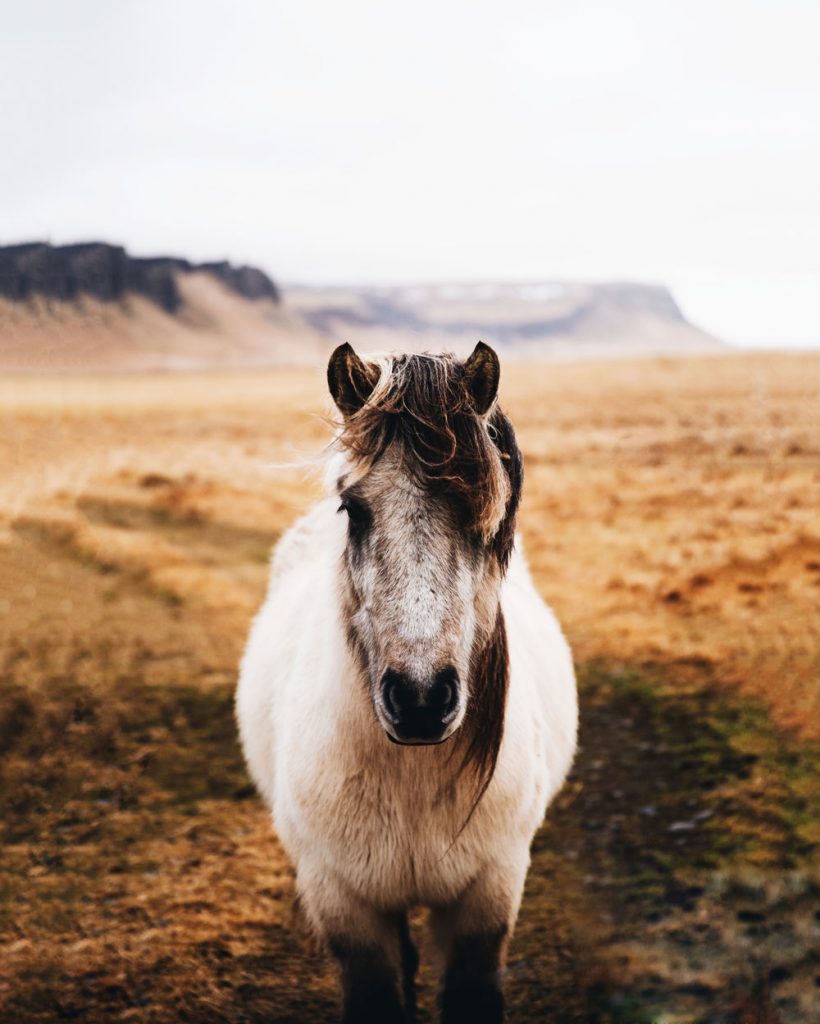
Our travel route – 5 days on iceland’s south coast
We spent 5 days in South Iceland and our route went from Keflavik to Jökulsarlon and back again. Jökulsarlon is an ice lagoon, located below the glacier Vatnajökul, where the ice caves are located. The trip is 420 kilometers and driving that stretch takes 5 hours. We thought it was too long to drive on a single day, and it is not recommended to drive from Reykjavik / Keflavik and try to do an ice cave tour on the same day. The weather is unpredictable and it can easily take longer than you think. And you certainly don’t want to lose your booking! Therefore, in addition to our two nights at Jökulsarlon, we had an overnight stay halfway through. That meant we were able to see some of the other amazing sights along the south coast. And there are so many of them!
How to travel to South Iceland on a budget
Iceland is typically described as a really expensive destination, but we were actually quite surprised at how cheap it was. We researched flights and ended up flying there on a Wednesday and home on a Monday. The cost for the two of us flying from Copenhagen was 230 EUR up and 295 EUR back (we could have made it even cheaper if we had been willing to fly home at 6 am).
We found the cheap tickets on Momondo’s search engine (which have just been voted the market’s best travel search engine in Denmark).
A couple of the nights we slept in cabins and made our own food. One night we stayed at a self-catering hotel without staff and another night at a private B&B with shared bathroom. All in all, the prices weren’t too bad. The accommodation cost was about 100 EUR per night.
Find the cheapest flight to Iceland with Momondo’s search engine
Find the cheapest accommodation in Iceland here
Car hire and driving in Iceland
Of course the best way to experience Iceland is with a four-wheel drive, but you can still see a lot in an ordinary car. We rented our little polo for just 190 EUR for 5 days. And with a tight budget and schedule, we decided to see the things we could reach in a regular car and save the money for the ice cave tour. I’m only sad that we could not drive into Dyrholaey, a super beautiful arch. It turned out that the road is not accessible with a regular car.
As long as you stay on Ring Road, or Route 1 as it is also called, it’s really easy to drive in Iceland. The ring road takes you all the way around Iceland on a good paved road, and there are no crazy inclines or hairpin bends along the way. If you veer off the main road, expect dirt tracks and potholes. That being said, all the sights in this guide can easily be reached with a regular car.
Many people travel to Iceland without renting a car, staying in the Reykjavik area taking a few small bus trips. I think that’s a shame, because the farther you get from Reykjavik, the more beautiful the sights. The buses are also too expensive compared to renting a car.
Find car hires in Iceland here
Day 1: from Keflavik to Lambafell
Driving from Keflavik to Lambafell, 2 1/2 hours, 184 km.
We land in Keflavik in the afternoon, driving south right away to Lambafell – a small collection of holiday homes not far from Skogar. We have chosen to stay here because it is located in the middle of nowhere. We don’t want to stay in the city, but rather in the open countryside, near the mountains and with the least possible light pollution, in the hopes that we will be able to just step outside the door and experience the Northern Lights dancing across the sky.
In Lambafell we stay in a small cabin where we also save money by making our own food. A great place that I can really recommend.
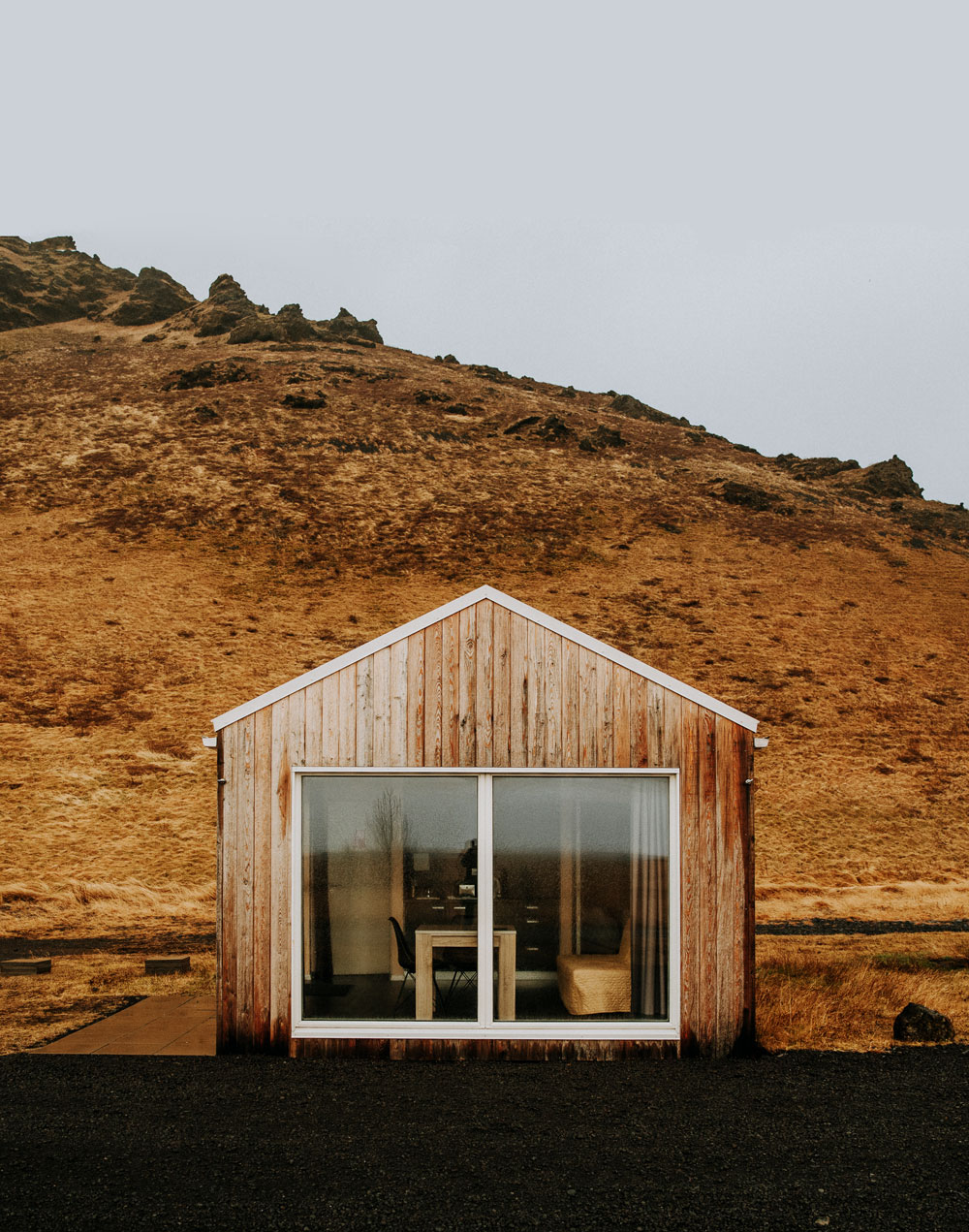
Day 2: Morning bath in a hot pool and a black beach with basalt columns
Drive from Lambafell to Jökulsarlon, 3 hours, 226 km
Day 1 was all about getting from A to B, but on Day 2 we are finally ready for adventure. In the morning we go to the Seljavallalaug pool, which is not far from our cabin, just a five-minute drive to a small parking spot and then 20 minutes’ walk. The trail takes us through a rocky landscape into a valley and over a rushing stream. There is a small house where you can get changed. The water is hot and it is great to lie here in the water, surrounded by the beautiful landscape.
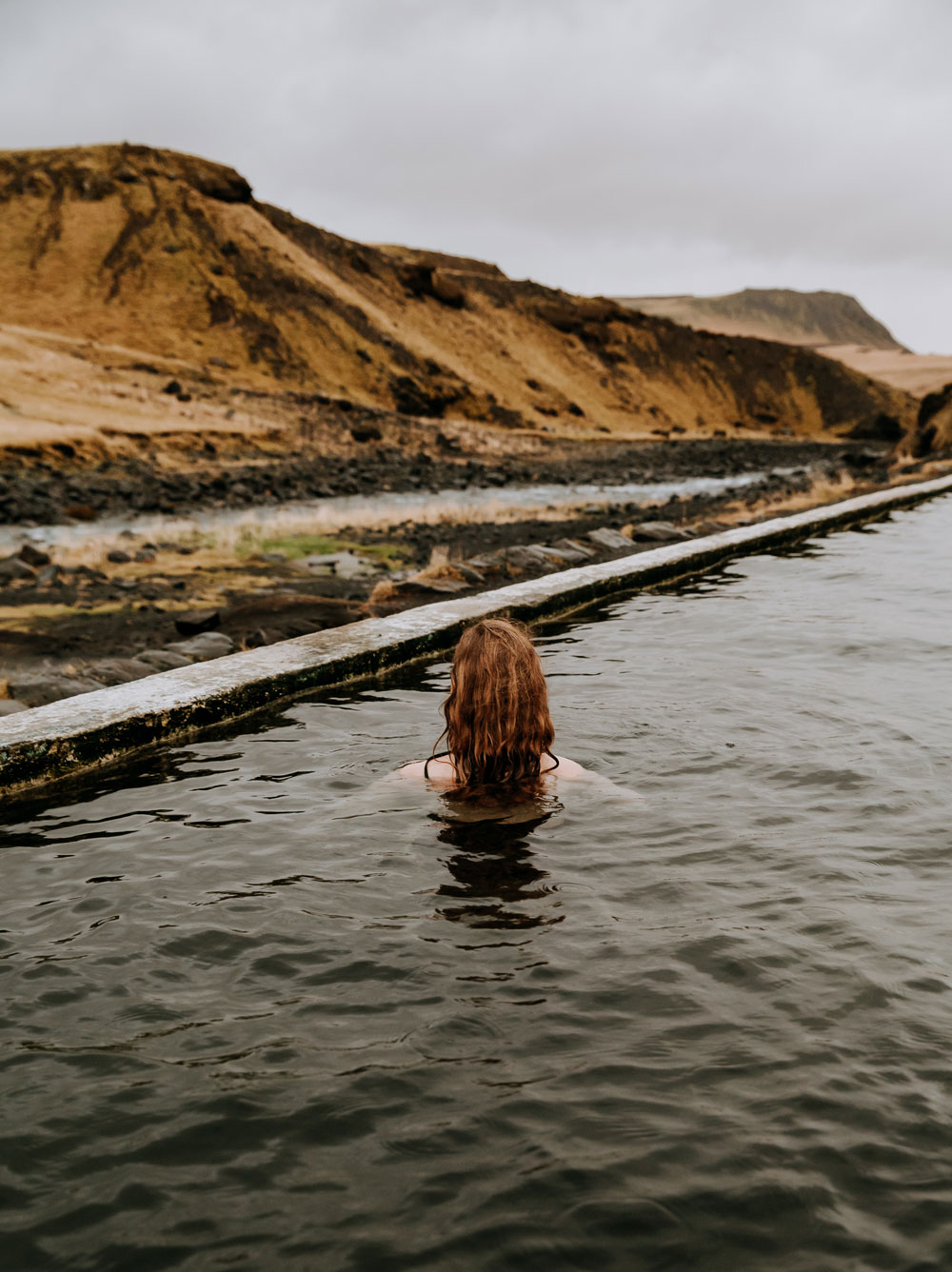
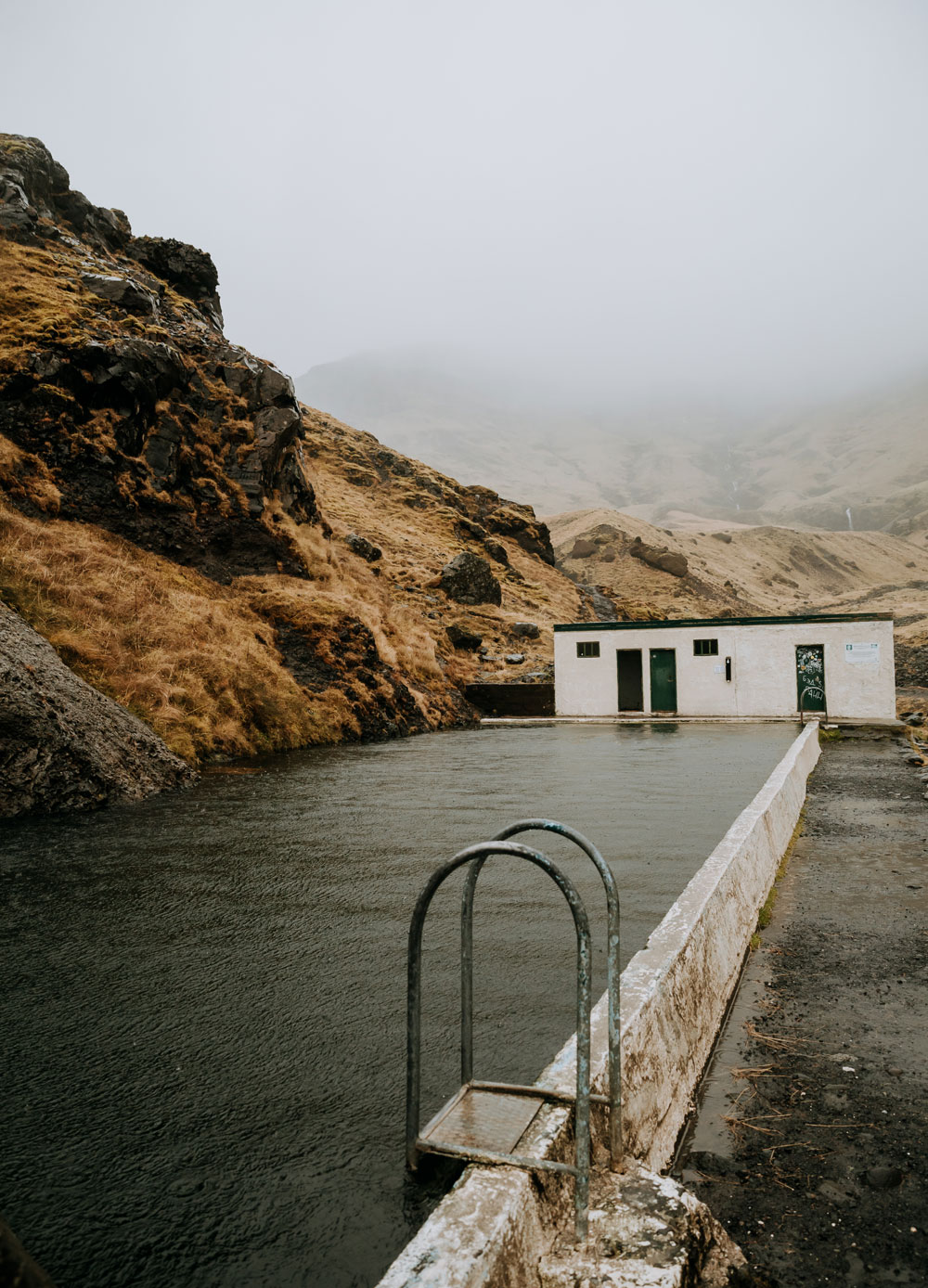
Reynisfjara Beach
The next stop is Reynisfjara Beach, another one of South Iceland’s famous sights – and with good reason. Black sand, basalt columns and the roaring sea with waves so powerful that a tourist drowned here last year. The scenery of Iceland is beautiful but harsh, so you always have to be respectful of nature and behave sensibly.
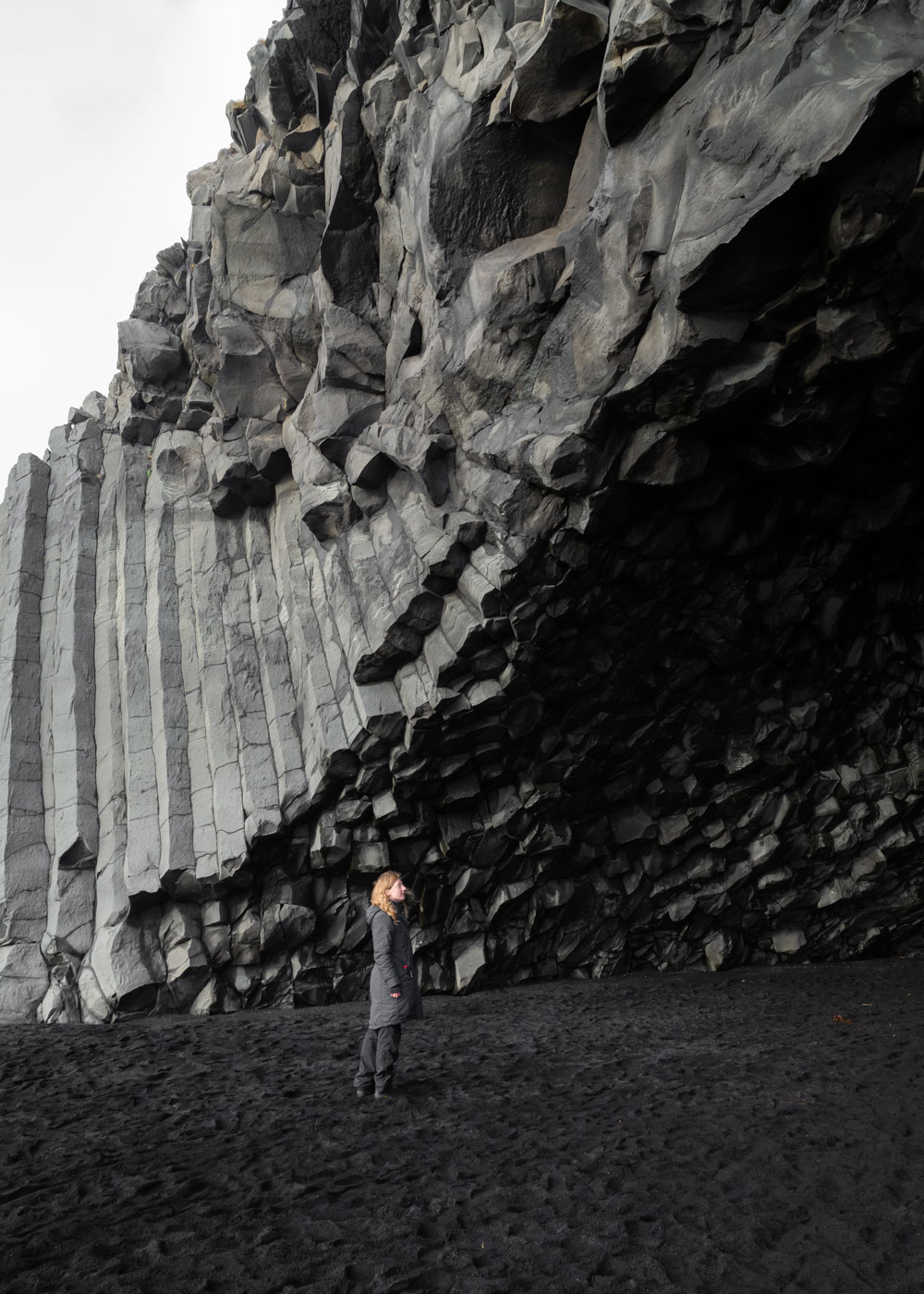
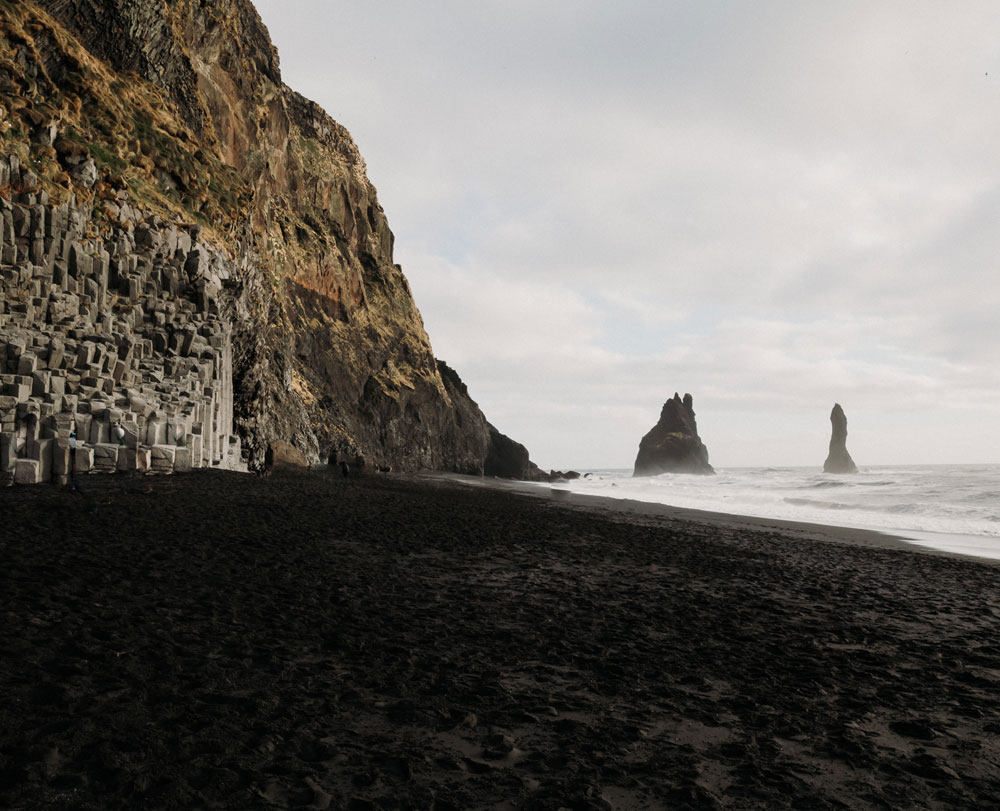
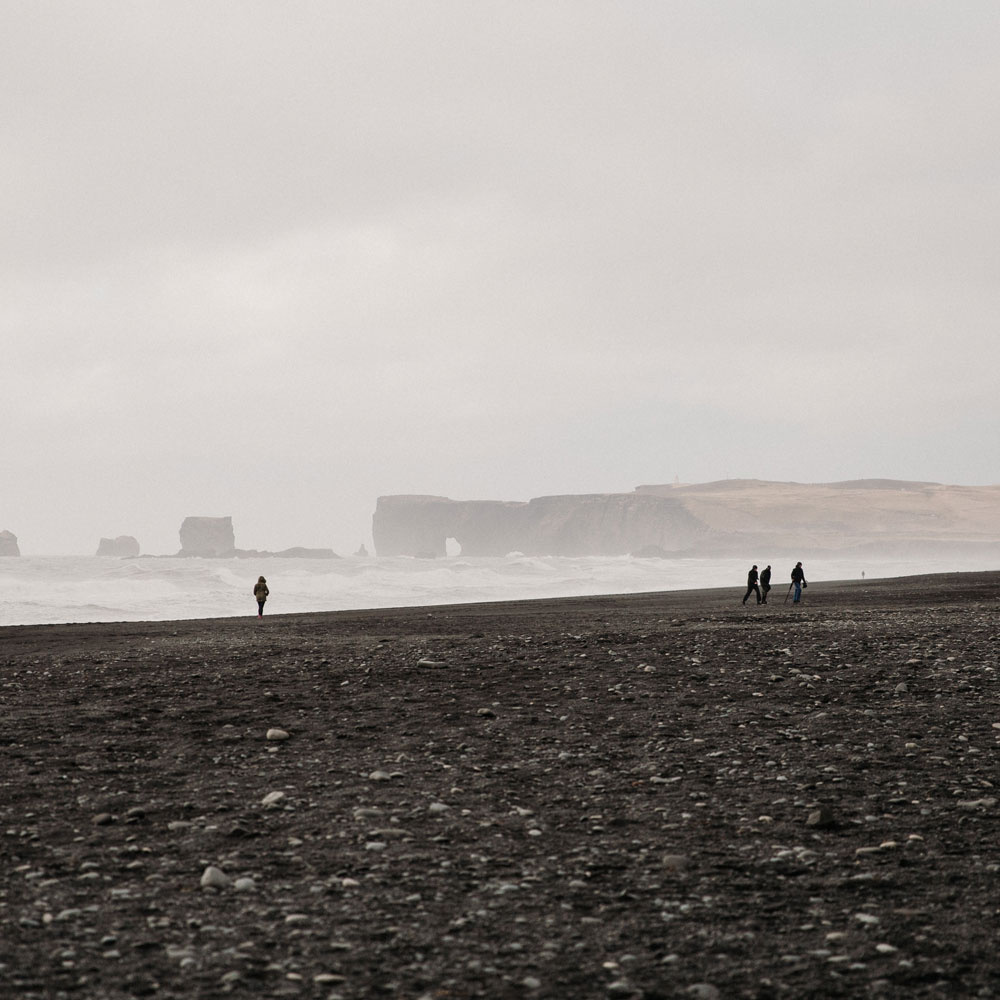
Infinite landscapes of nothingness
After Reynisfjara we drive further east along the coast to our final destination, Jökulsarlon, and the little B&B where we will be staying. We weave through Iceland’s diverse landscapes. I’m wildly fascinated by the scenery of South Iceland – both the dramatic views and the slightly less hyped ones. They flicker constantly between endless meadows with horses and reindeer to mossy stones as far as the eye can see.
At Jökulsarlon we stay at a privately owned B&B, which you can find here
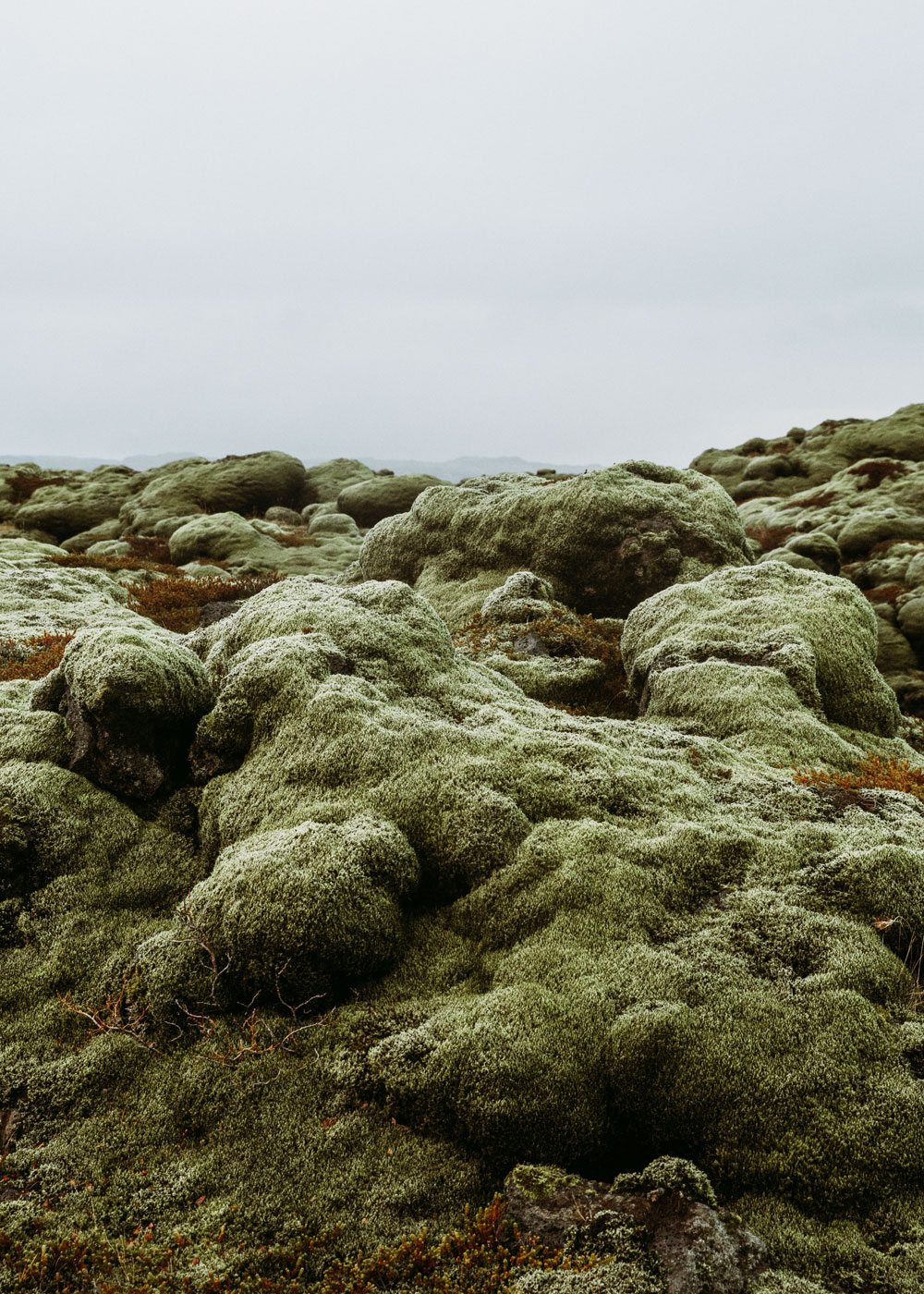
Dag 3 – down in a glacier of blue ice
Driving: From Jökulsarlon to Stokksnes and back again, 1 hour and 86 km each way
We have reached the climax of the trip: the ice cave. I have read that ice cave tours are an extremely popular attraction, and that you should therefore book an extended photo tour if you want to take pictures of the cave. The longer trip typically takes 7 hours, and includes walking a few kilometres across the glacier to a cave that is more difficult to reach. For that reason, there are fewer tourists. The regular, shorter trips take 3 hours, but you should be prepared to share the cave with many others.
You cannot experience the caves on your own, as it is dangerous to walk on the glacier without a guide.
I chose to book a regular trip, but I booked the trip with the earliest start time I could find (8.50am), in the hope that there would be fewer people. I did this both because of the tight schedule and budget. But also because I thought the photos from the nearby caves looked more beautiful. There is a famous large cave called Crystal Cave, which can be extremely beautiful. But the caves are alive, the ice are changing from year to year and from day to day. The guides will always try to take you to the most beautiful cave at the time of your visit.
In a monster truck across the ice
At 8.50 am we are ready at the café at Jökulsarlon, where the trip begins and we soon find our guide and the huge monster truck that are going to take us to the cave. It’s raining, but we’re assured that rain is the very best weather for experiencing the ice cave. The rain washes away the dirt and gravel so that the colour of the ice gets even clearer. Our guide also tells us that the big cave (Crystal Cave) is not looking its most beautiful right now. The cave we are going to see is smaller, but on the other hand it has the most beautiful blue color.
The trip there is an experience in itself. We drive on the paved road for a little while, but soon drives off road into a landscape that mostly resembles the moon. Our guide tells us that many moon films have been recorded here and that NASA occasionally uses the area to simulate moon landings. We really do feel like we are on another planet.
Our monster truck drives over the craziest pot holes until we reach the edge of the glacier. We get into another car that brings us over the ice. We put crampons on our boots to ensure we can stick on the ice. The ice below us is clear like glass and we crawl along a rope down into a hole that leads into the cave. It is quite cramped in there, with a stream running through it – but oh, the color! The most beautiful blue color. I’m certainly not disappointed. It’s a tight squeeze with so many people, and I struggle to find room for my tripod without blocking the others, but I manage to get a few photos.
How to go on an ice cave tour
Ice cave tours are available elsewhere in Iceland, but the caves in Vatnajökul are by far the most beautiful.
We booked our trip with Guide To Iceland, which is one of the most established ice cave tour providers. However, there are many companies that offer ice cave tours, with all the same content and the same prices.
The ice caves at Vatnajökull are typically open from November to March.
Book the short 3-hour trip here (143 EUR per person)
The longer trip for photographers (the one I probably should have taken, 230 EUR per person)
A few tips for ice caves:
Solid hiking boots and rain gear are a must as the water runs down from the ceiling of the cave.
If you would like to photograph the cave, I would recommend putting a bag around your camera. It is relatively dark down there, so I would also recommend a tripod to avoid blurry images.
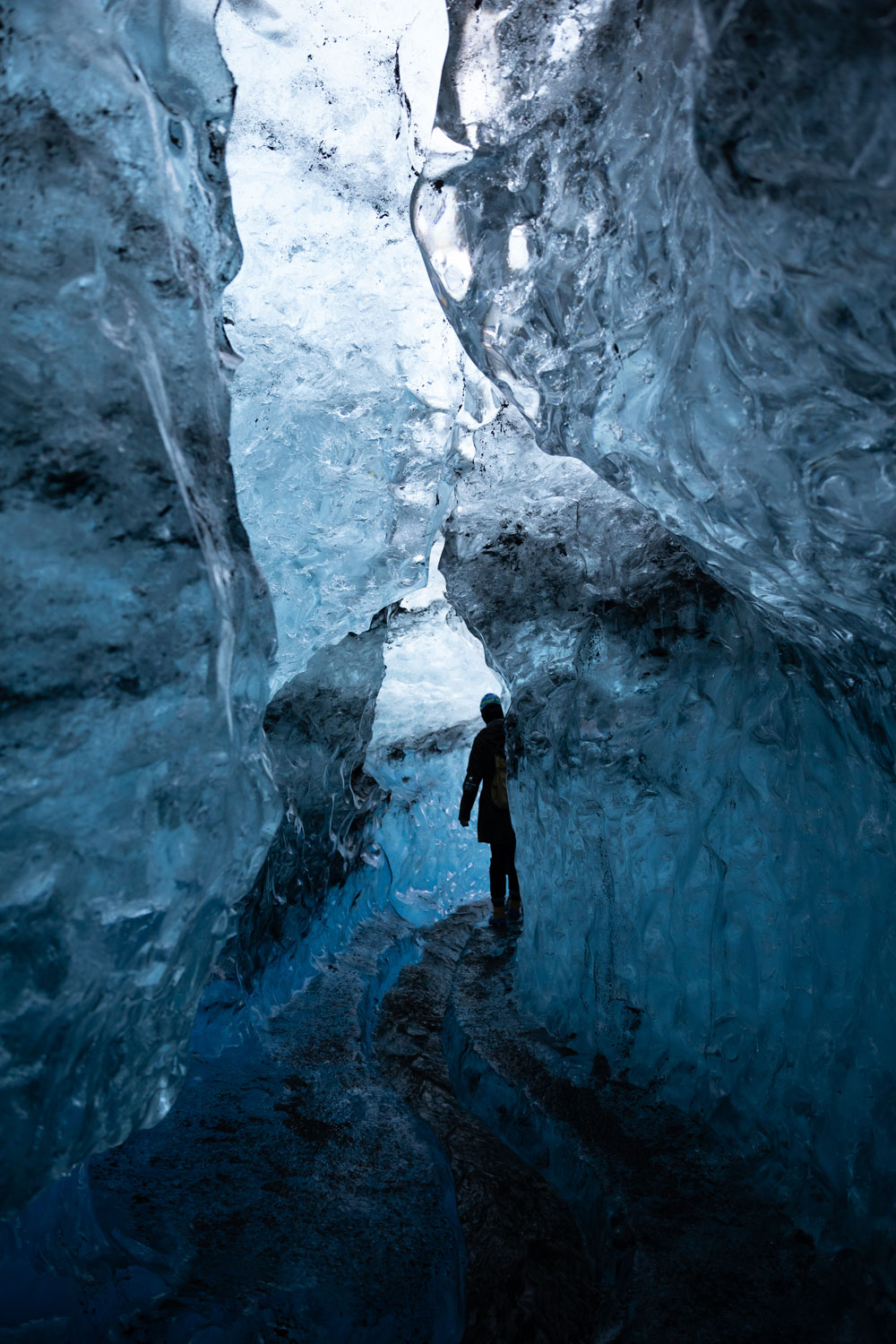
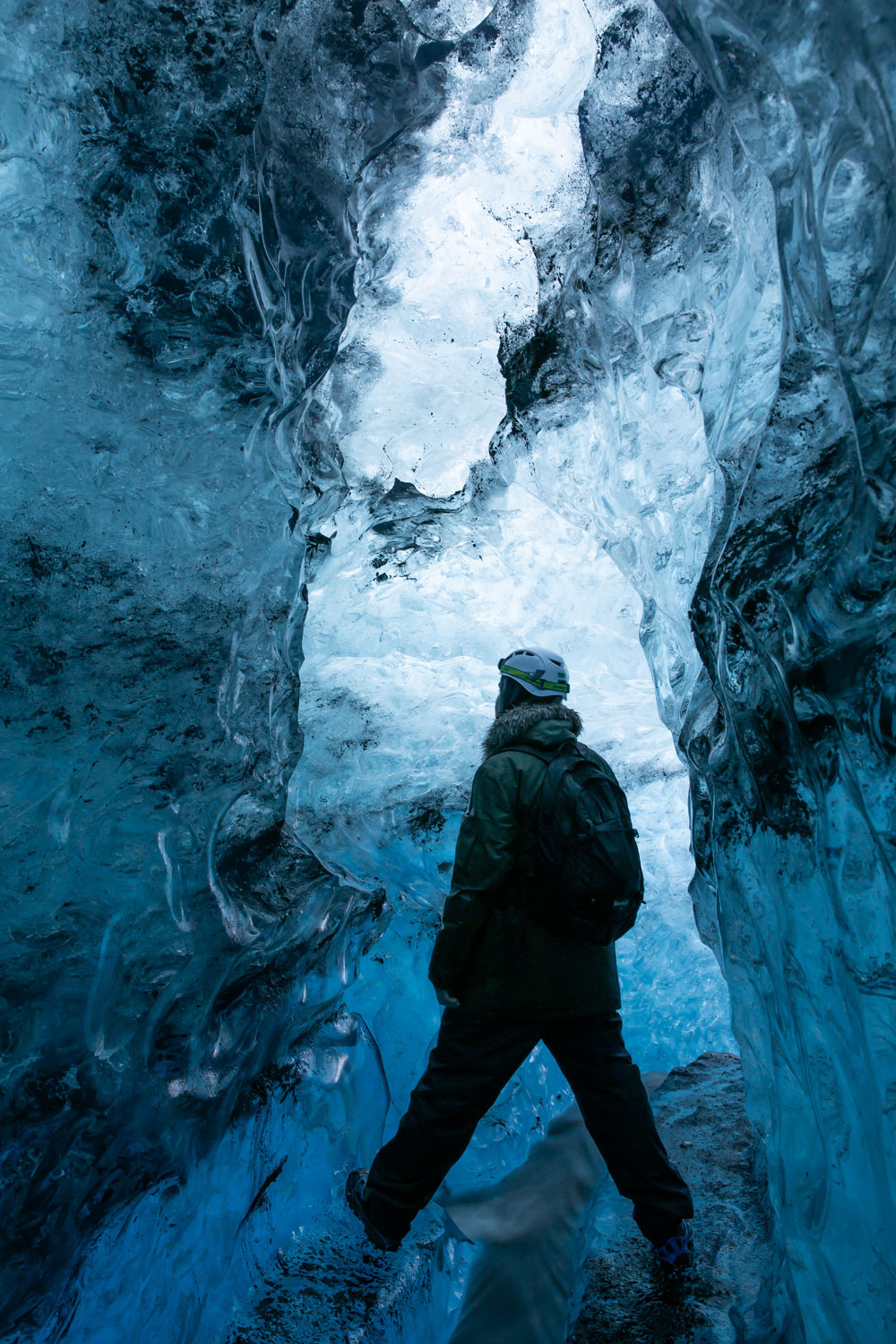
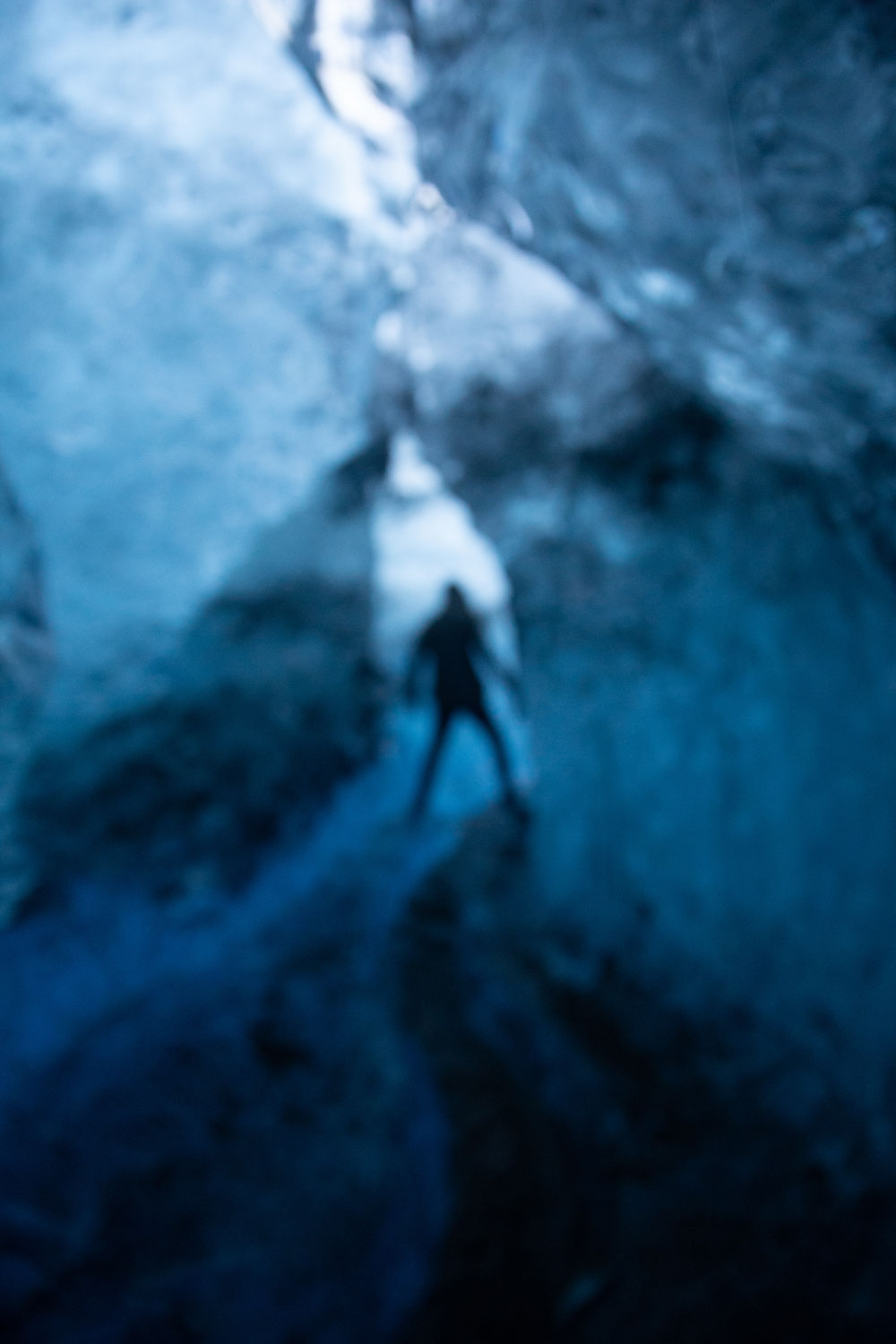
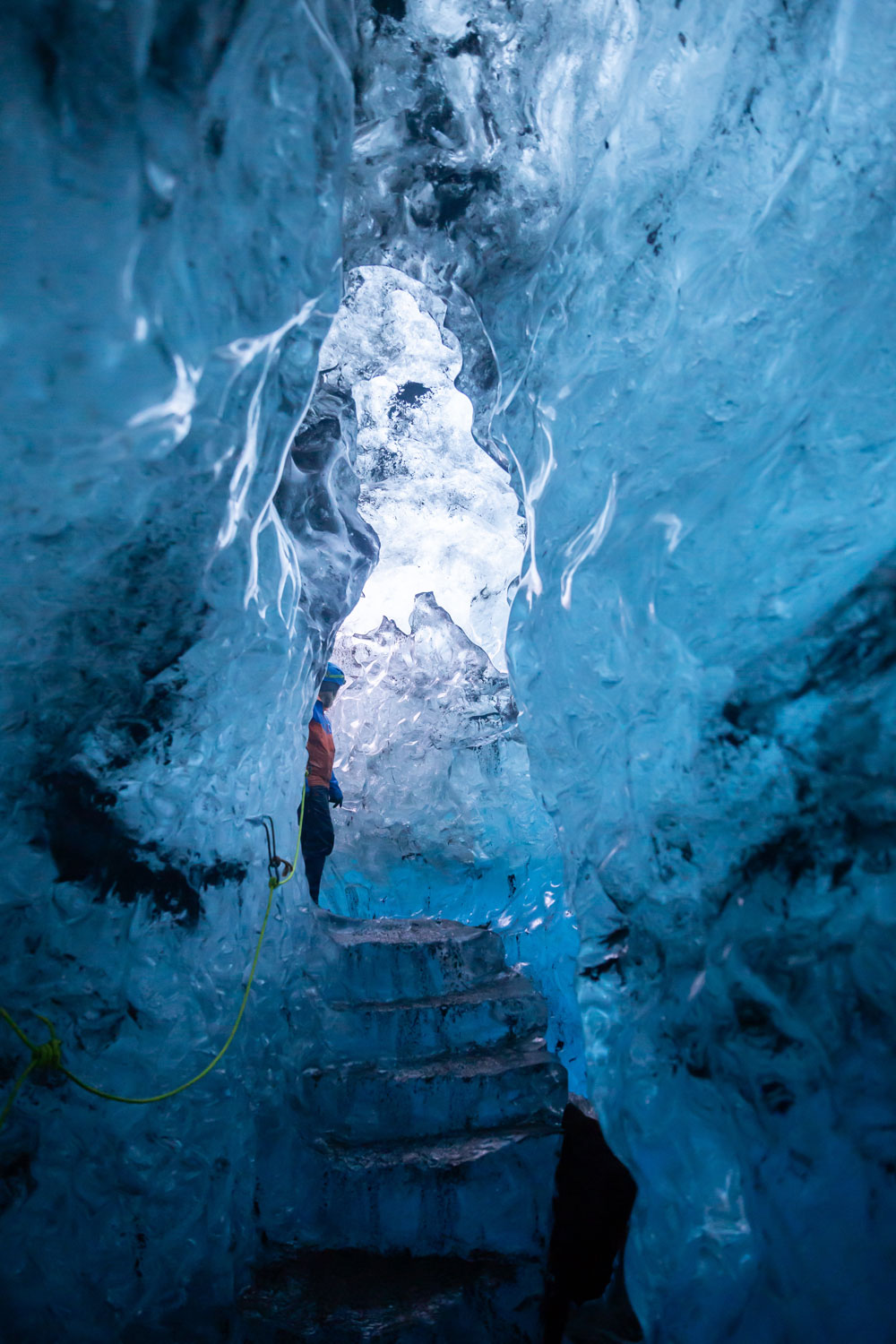
Stokksnes and the abandoned viking village
In the end I am glad that we only took the short ice cave tour, because then we also had time to drive out to this place in the afternoon. Stokksnes – or Vestrahorn as it is sometimes called – is a peninsula surrounded by steep mountains.
When we arrive at Stokksnes it feels like we have landed on another planet. At the end of the small gravel road there is a cafe, where you buy an entrance ticket to the area (6 EUR per person). Yes, it’s strange to pay entrance to a nature area, but the reason is that Stokksnes is privately owned.
If you walk over the hill behind the cafe you reach a viking village. It’s not a real viking village, but an abandoned film set, which nevertheless looks completely authentic in that magnificent landscape.
You can use your entry ticket to get through a small barrier system and onto the narrow road with water on both sides leading to the peninsula. Just before reaching the island, the landscape becomes completety moon like with black sand dunes and yellow grass. Again, we feel like we have left earth behind and are now on a completely different planet.
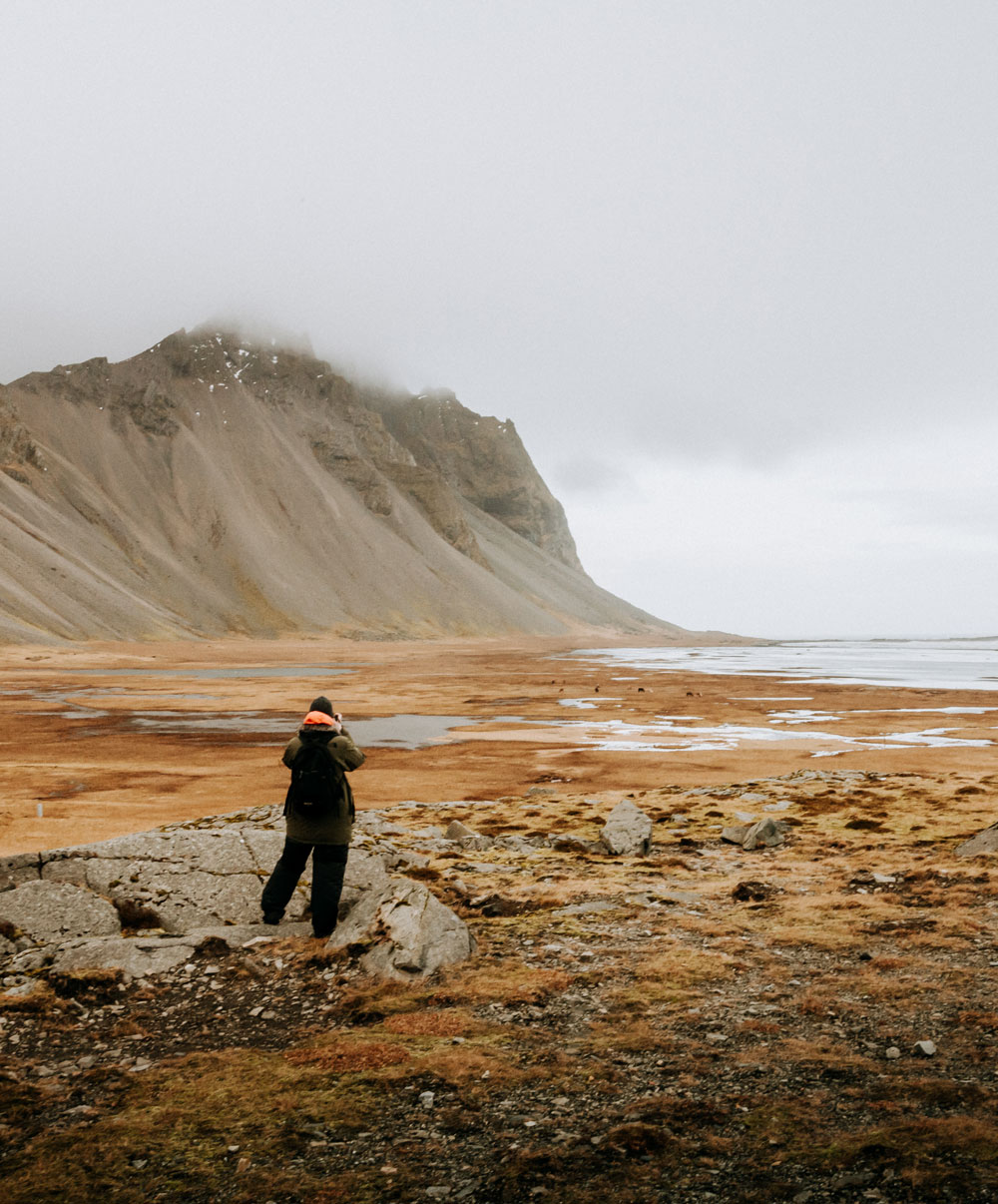
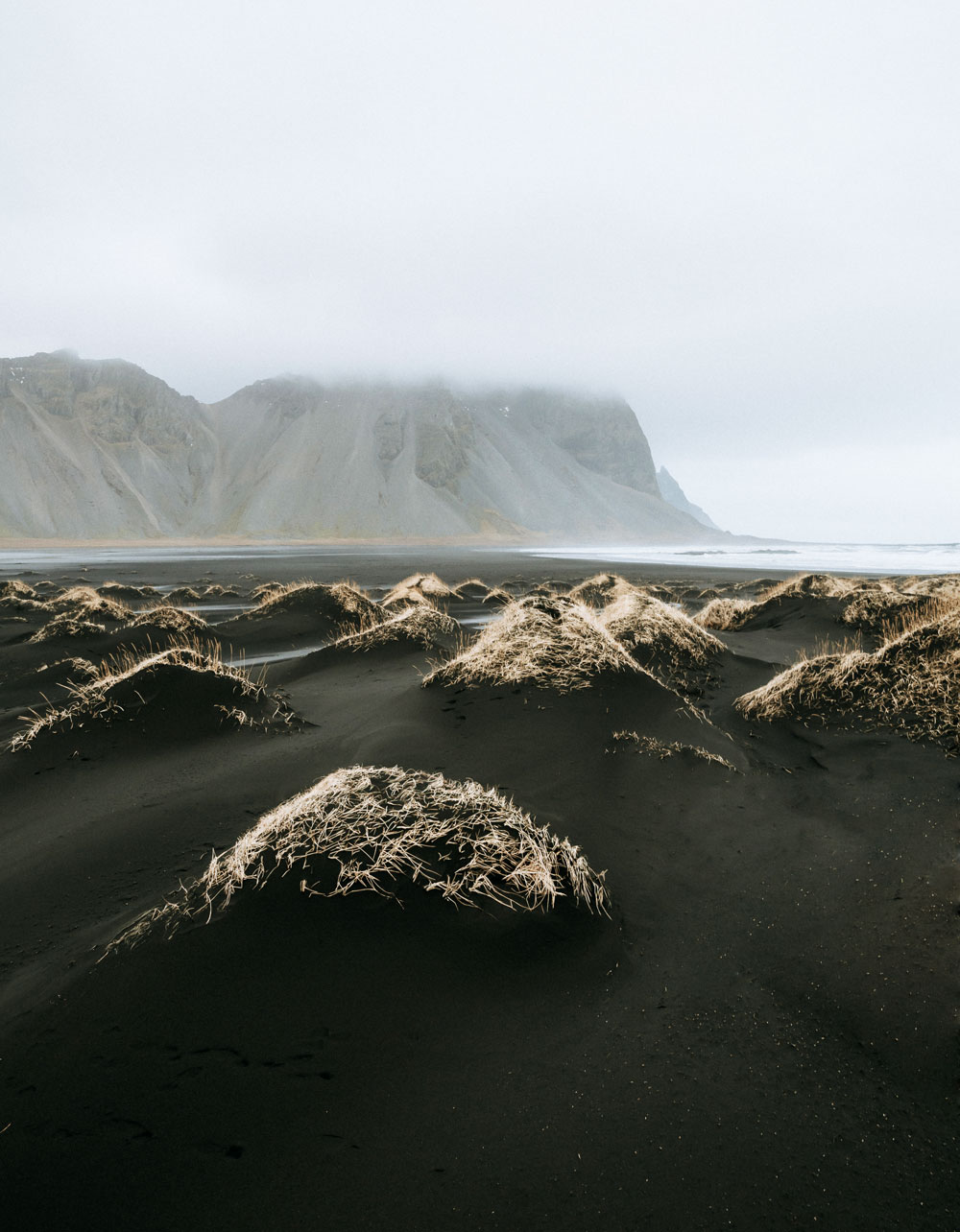
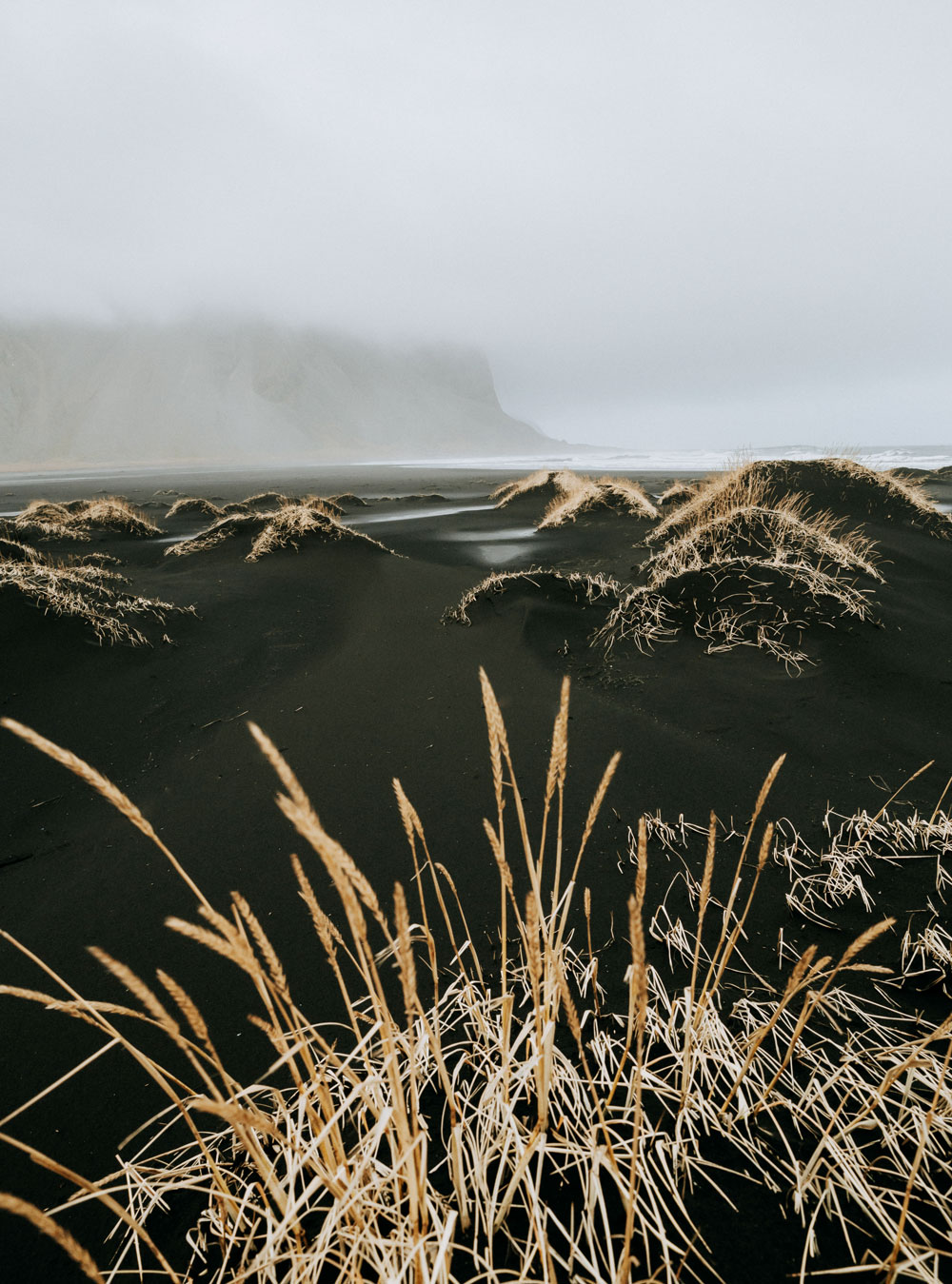
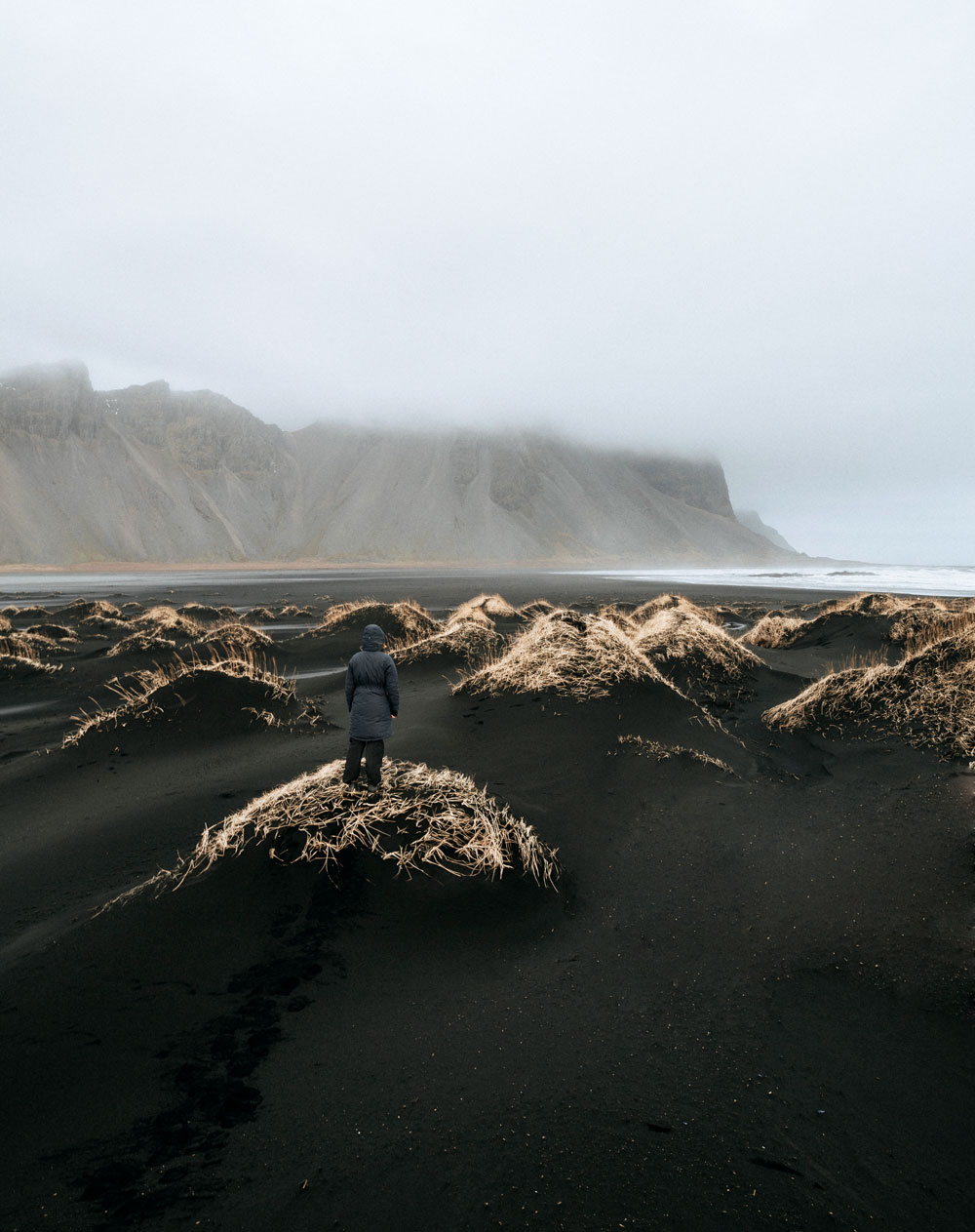
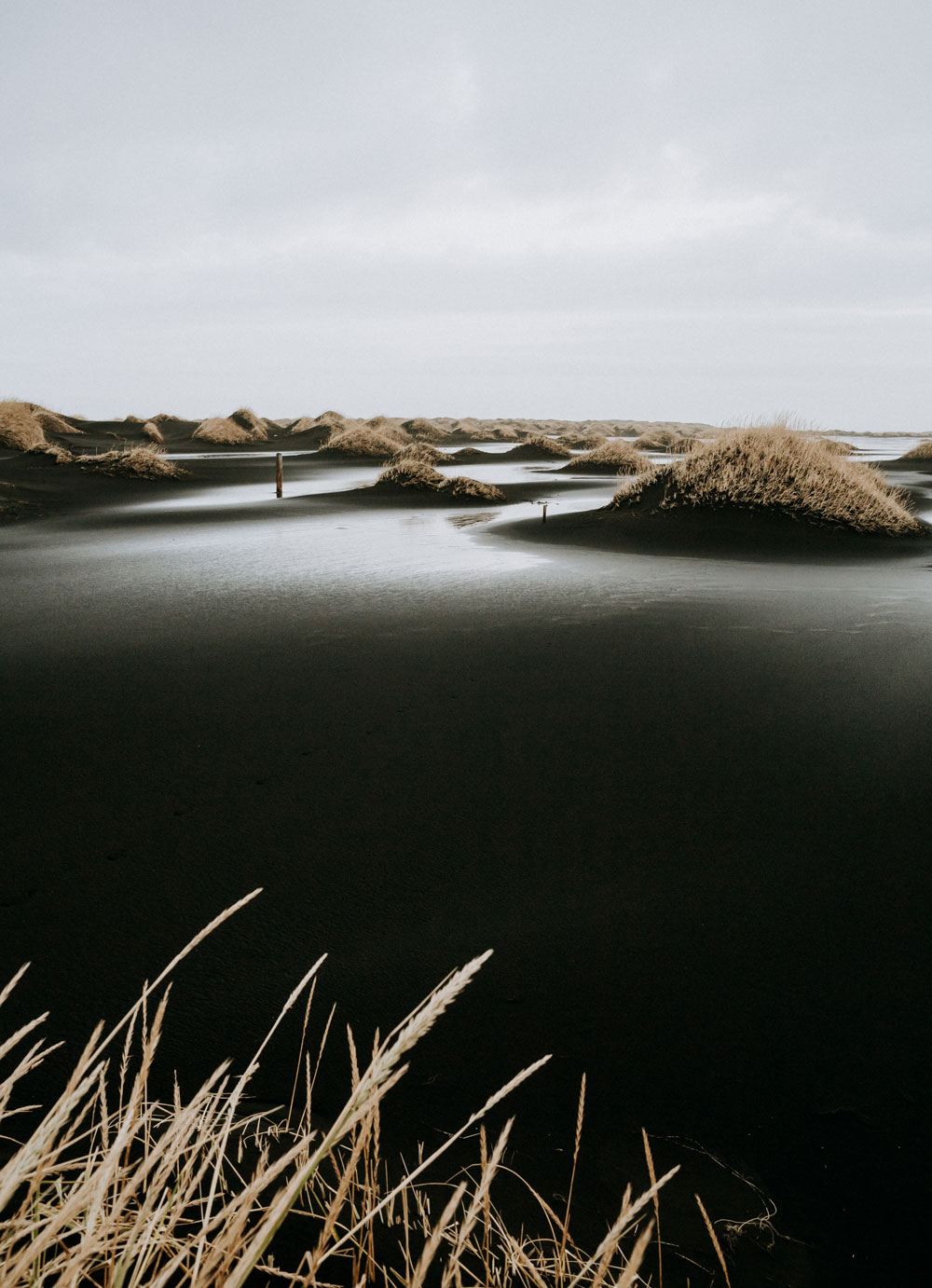
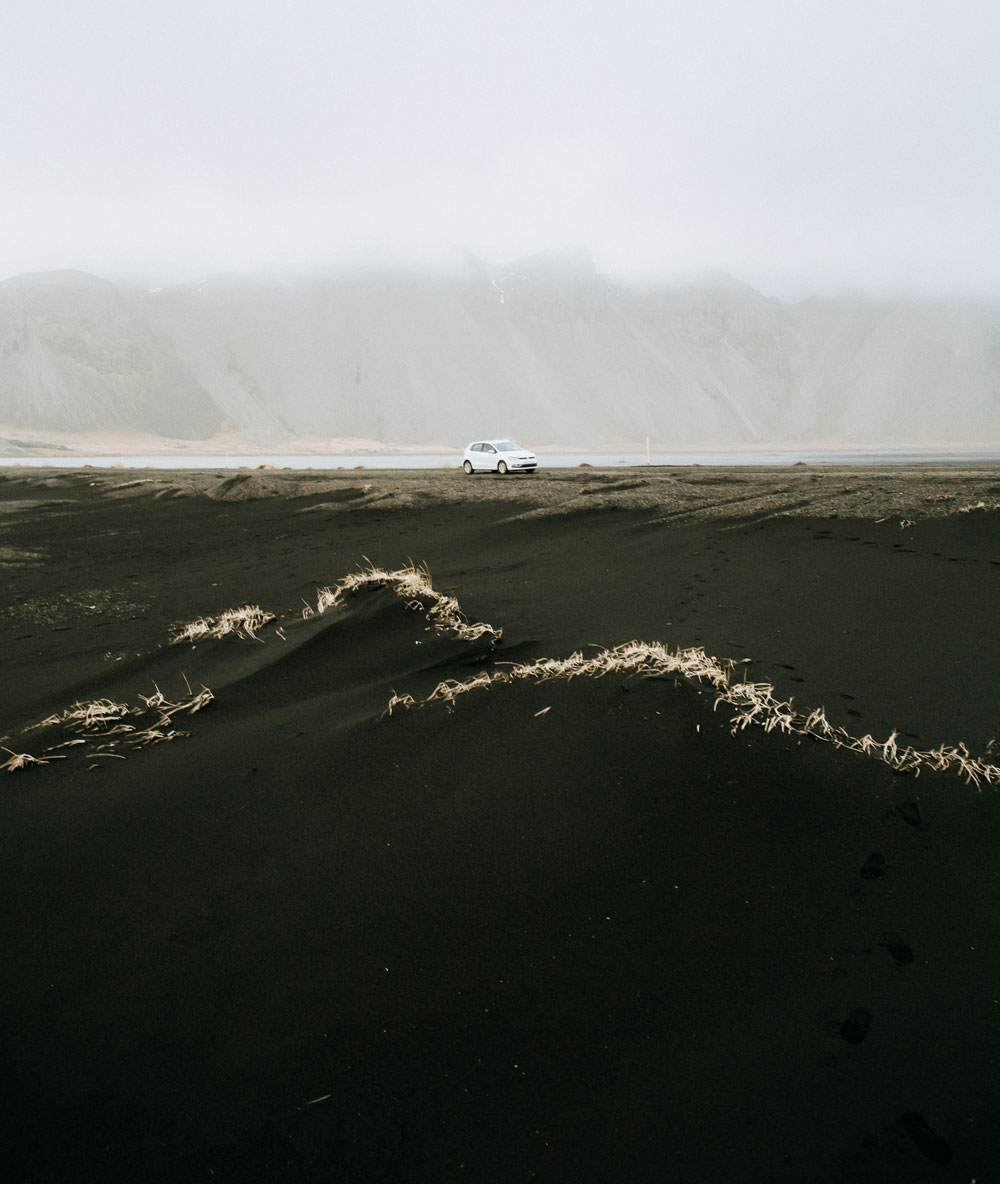
Our little white Polo looks like a moon car in the black sand landscape
Hoffell Hot Tubs
By 4.30 pm the daylight is disappearing and we head towards our B&B. On our way home we pass by Hoffell Hot Tubs and realise that a soak in the hot water would be the perfect end to the day. Five hot tubs are lined up under a rocky wall in the open countryside. The place is manned, has a changing room and costs approximately 8 EUR per person.
You’ll find Hoffell Hot Tubs here (on Google maps)
Dag 4 – Diamond Beach and cute Icelandic horses
Driving: From Jökulsarlon to Lambafell, 3 hours, 250 km
After another night in our private B&B near Jökulsarlon, it is time to move back towards Keflavik. The first stop is Diamond Beach, located right next to the ice lagoon. Chunks of ice that have been torn apart from the glacier are scattered across the beach. Some are one metre tall, others quite small. They look like little artworks as they lie in the black sand. The compressed glacier ice is clear like glass. It’s easy to see how the beach got its name.
It’s raining and blowing a hell of a gale, so it’s a bit of a challenge to take photos. I have to constantly wipe water drops off my lens.
The next stop is supposed to be Svartifoss, the beautiful waterfall surrounded by basalt columns. Since the waterfall is 40 minutes’ walk from the road and the weather is crazy, we decide to skip it. It’s a little bit annoying, but also something you can expect when in Iceland. The weather determines everything. Nevertheless, the day becomes full of lovely experiences anyway. We stop and say hi to a bunch of Icelandic horses before heading back to Lambafell. This time we will stay at the hotel, a charming log cabin.
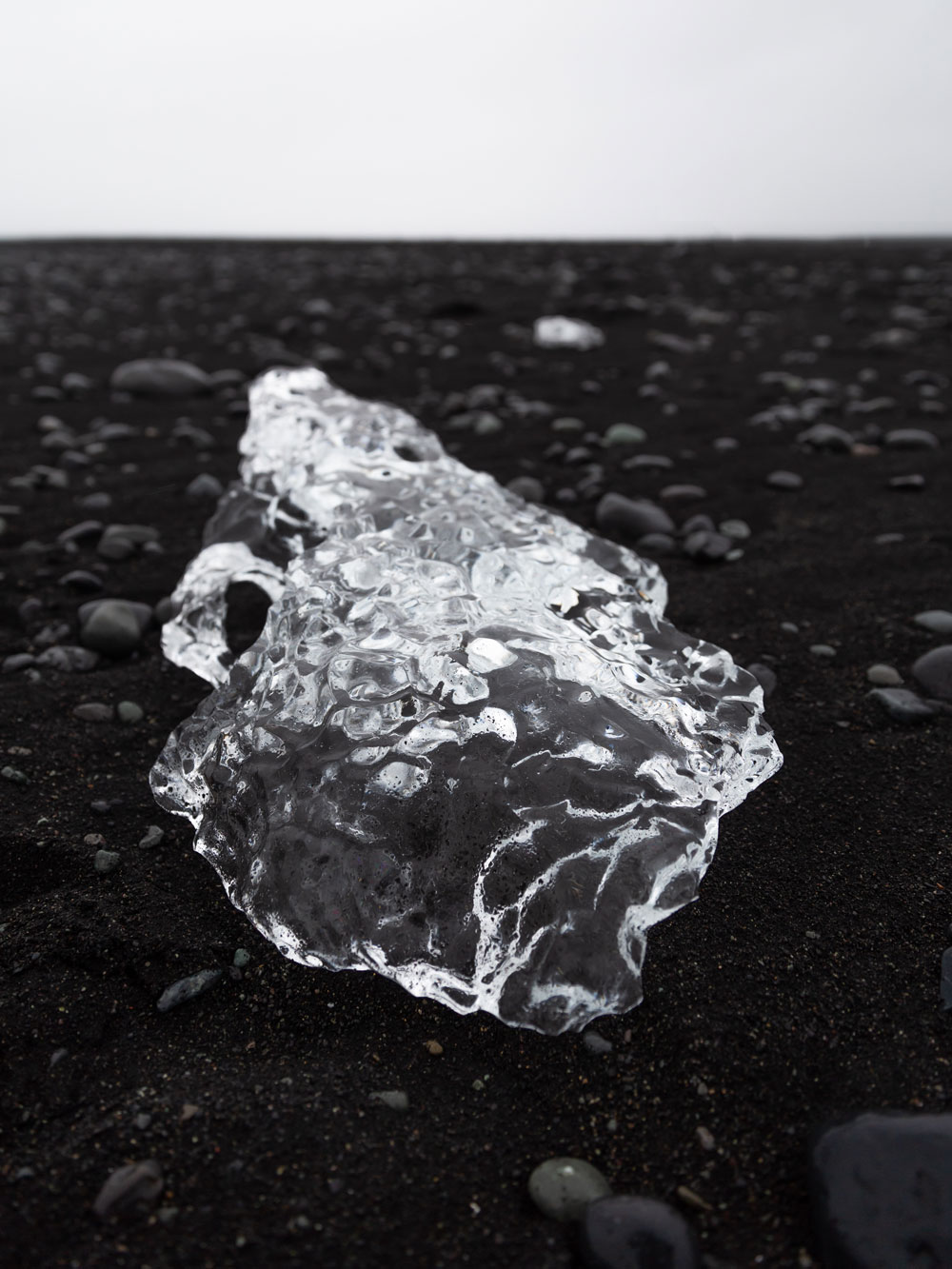
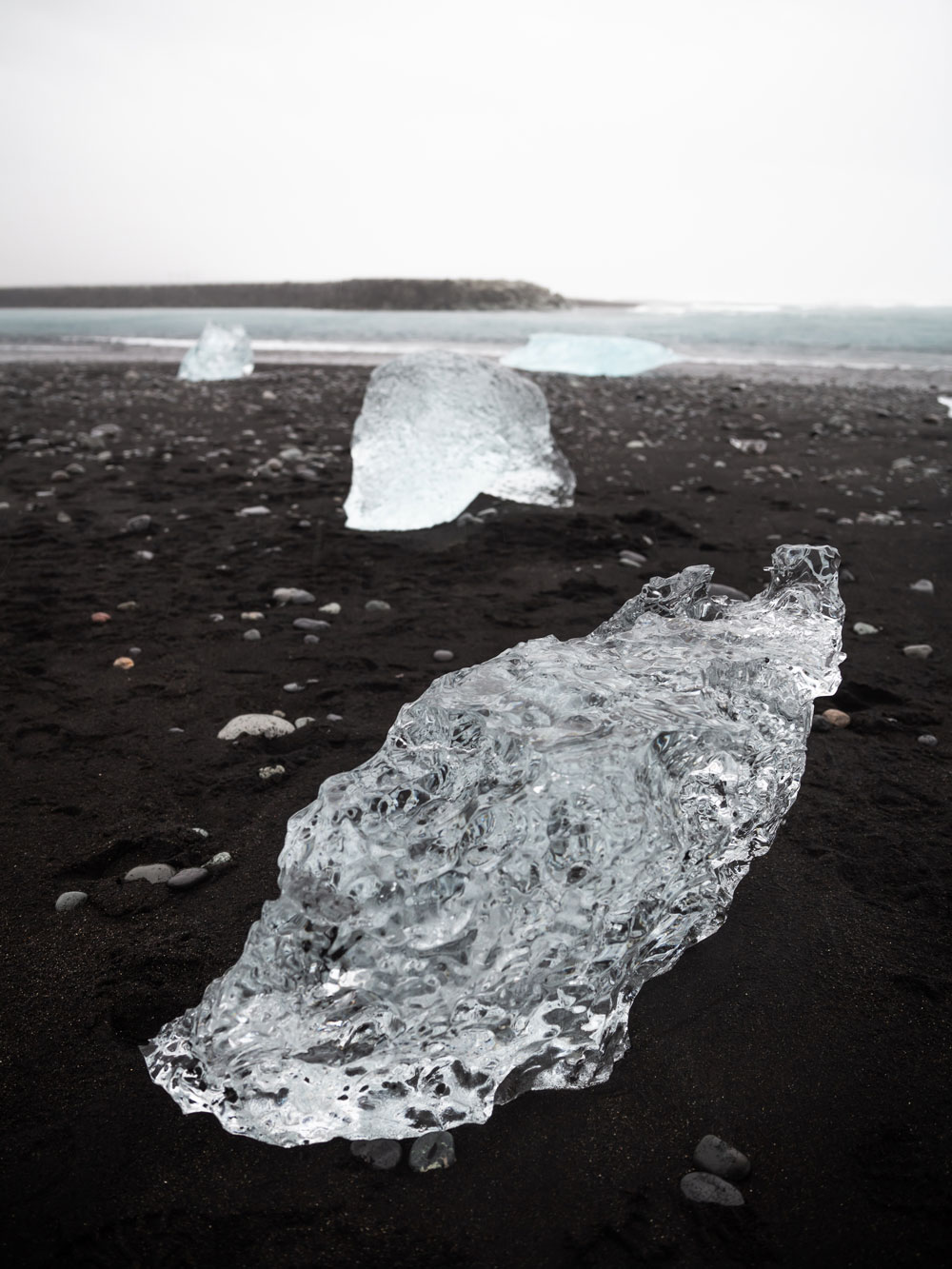
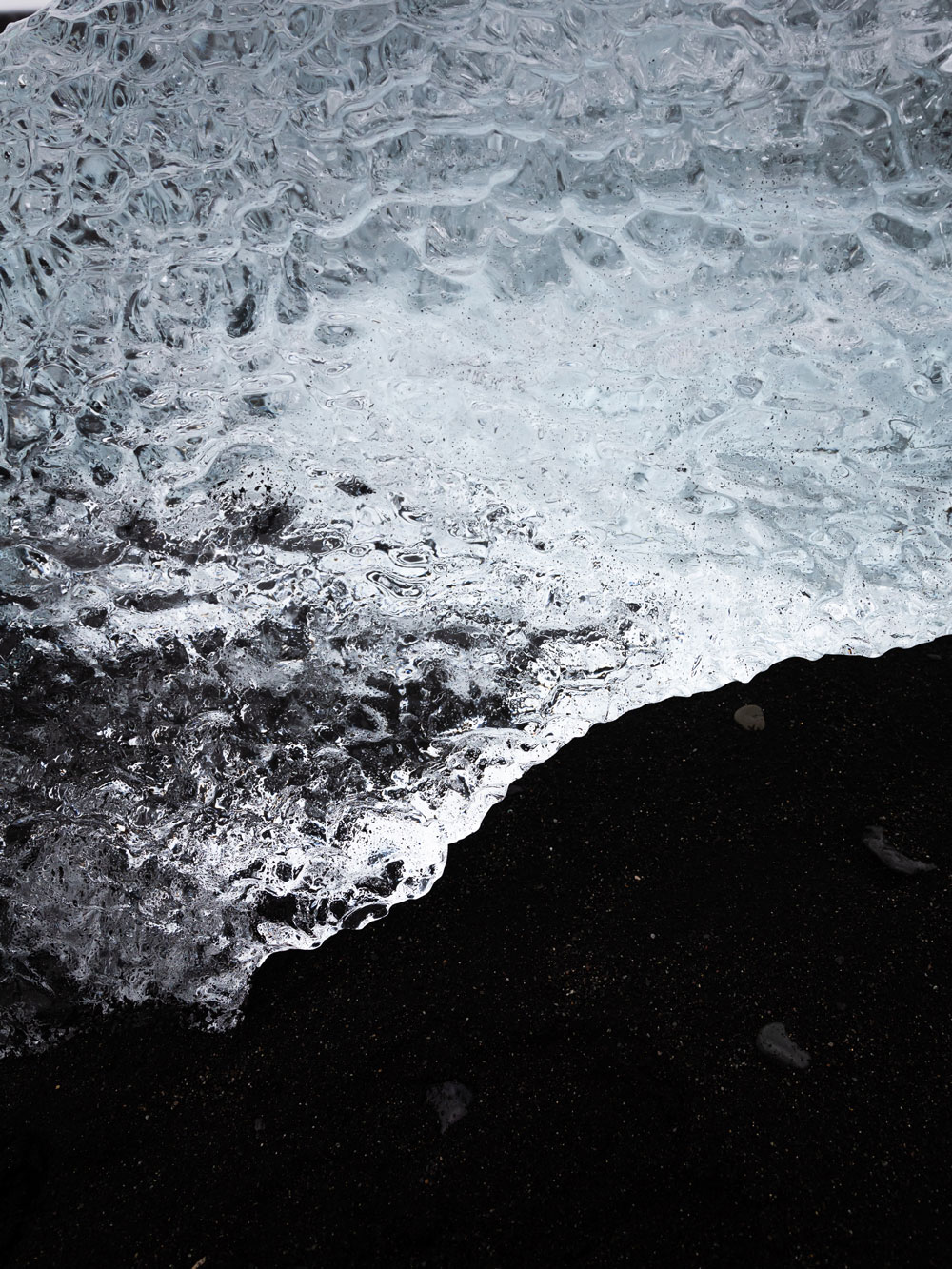
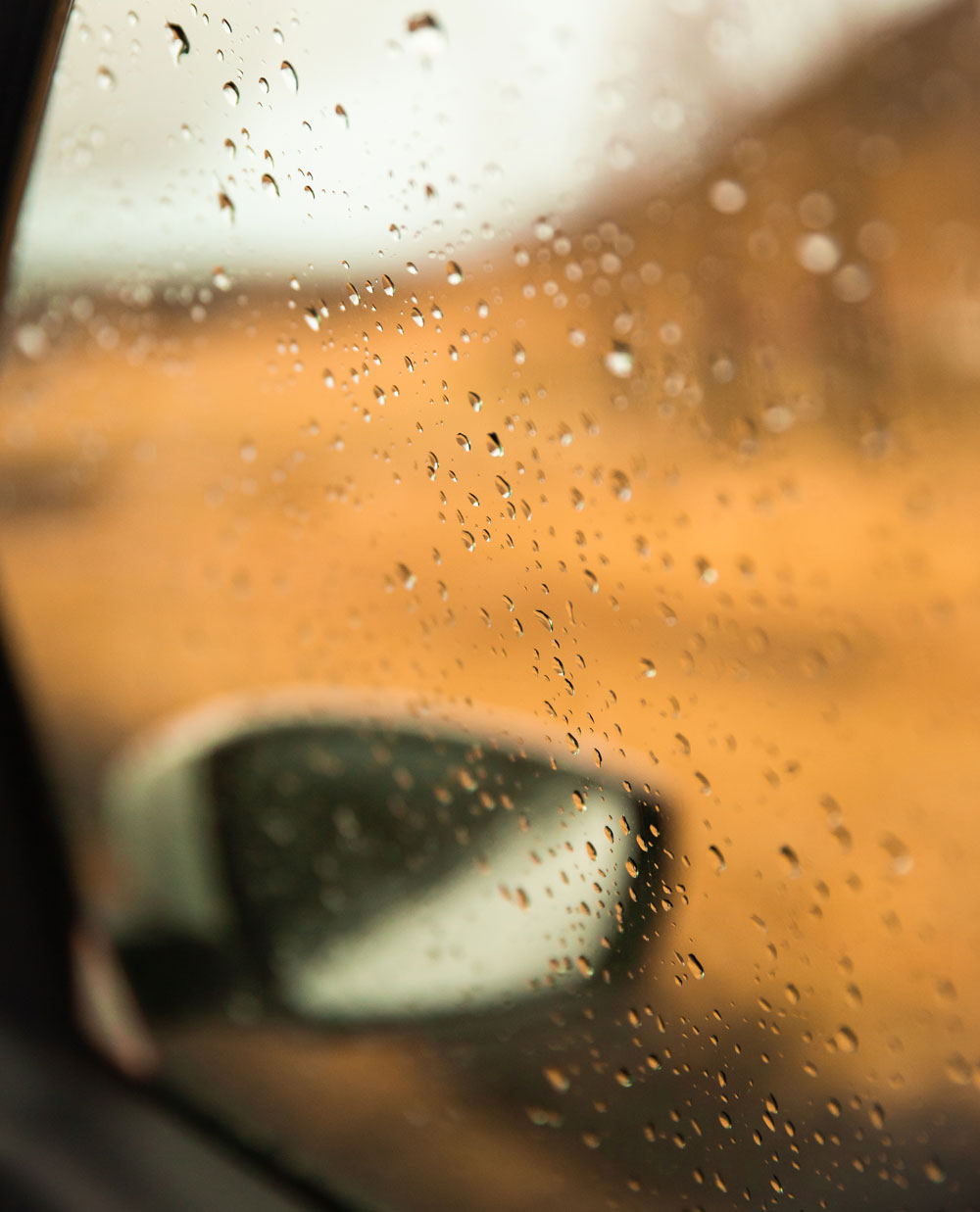
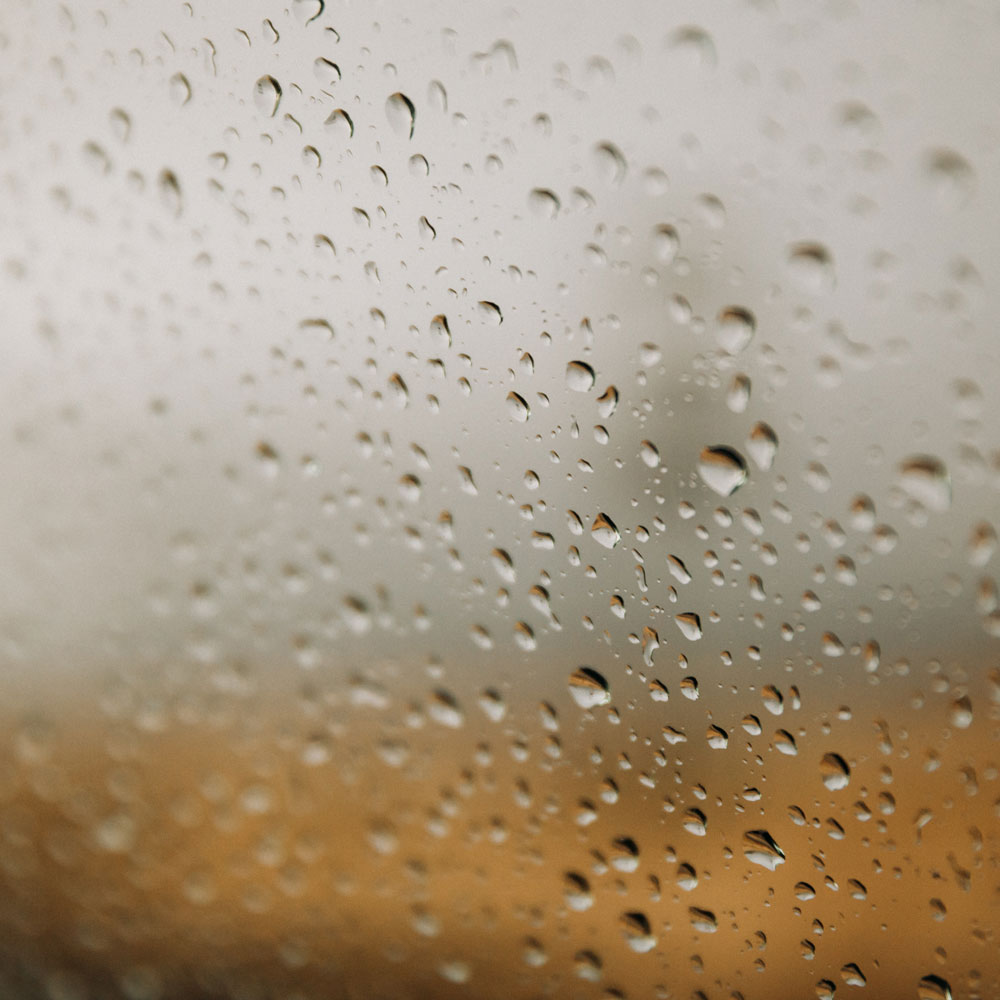
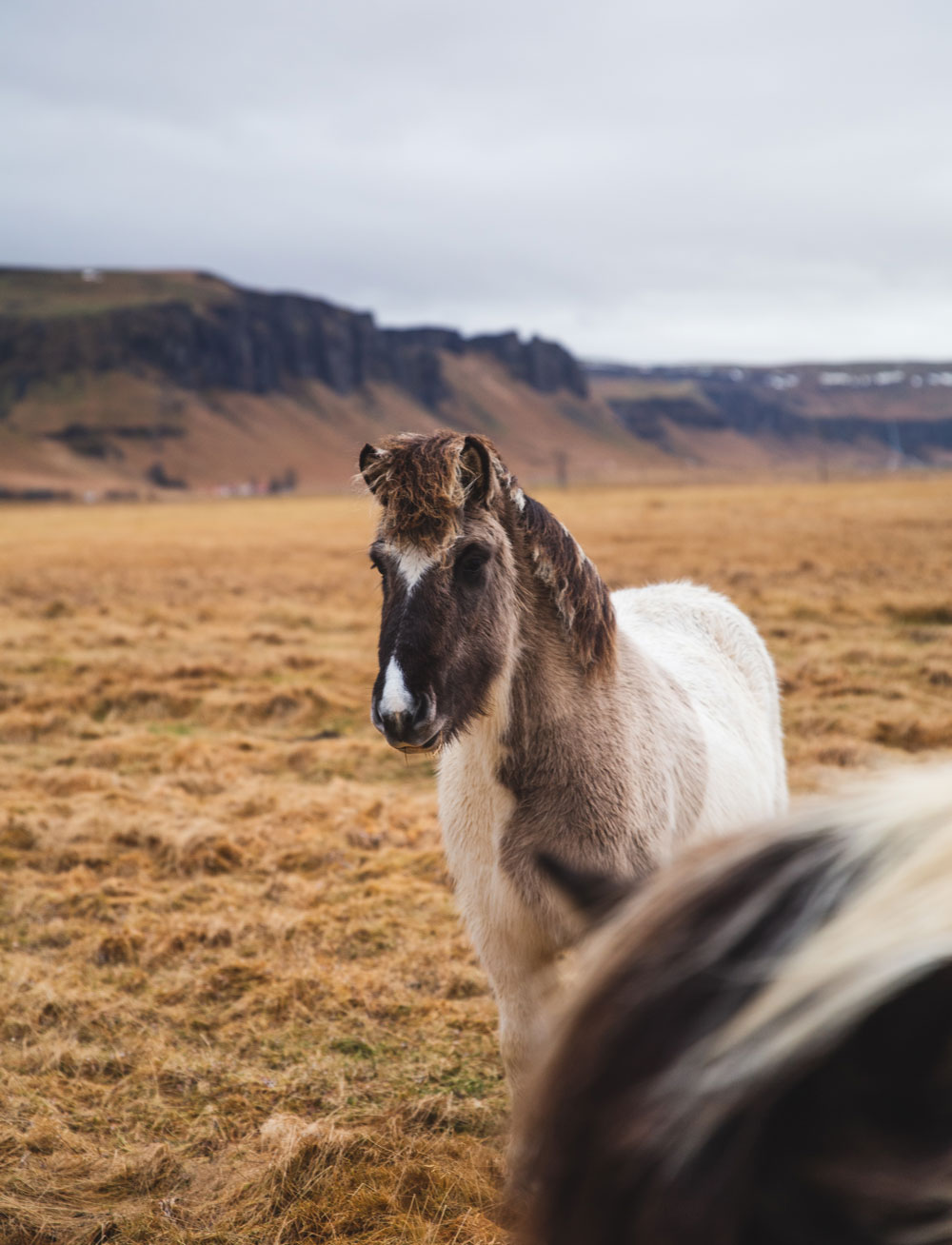
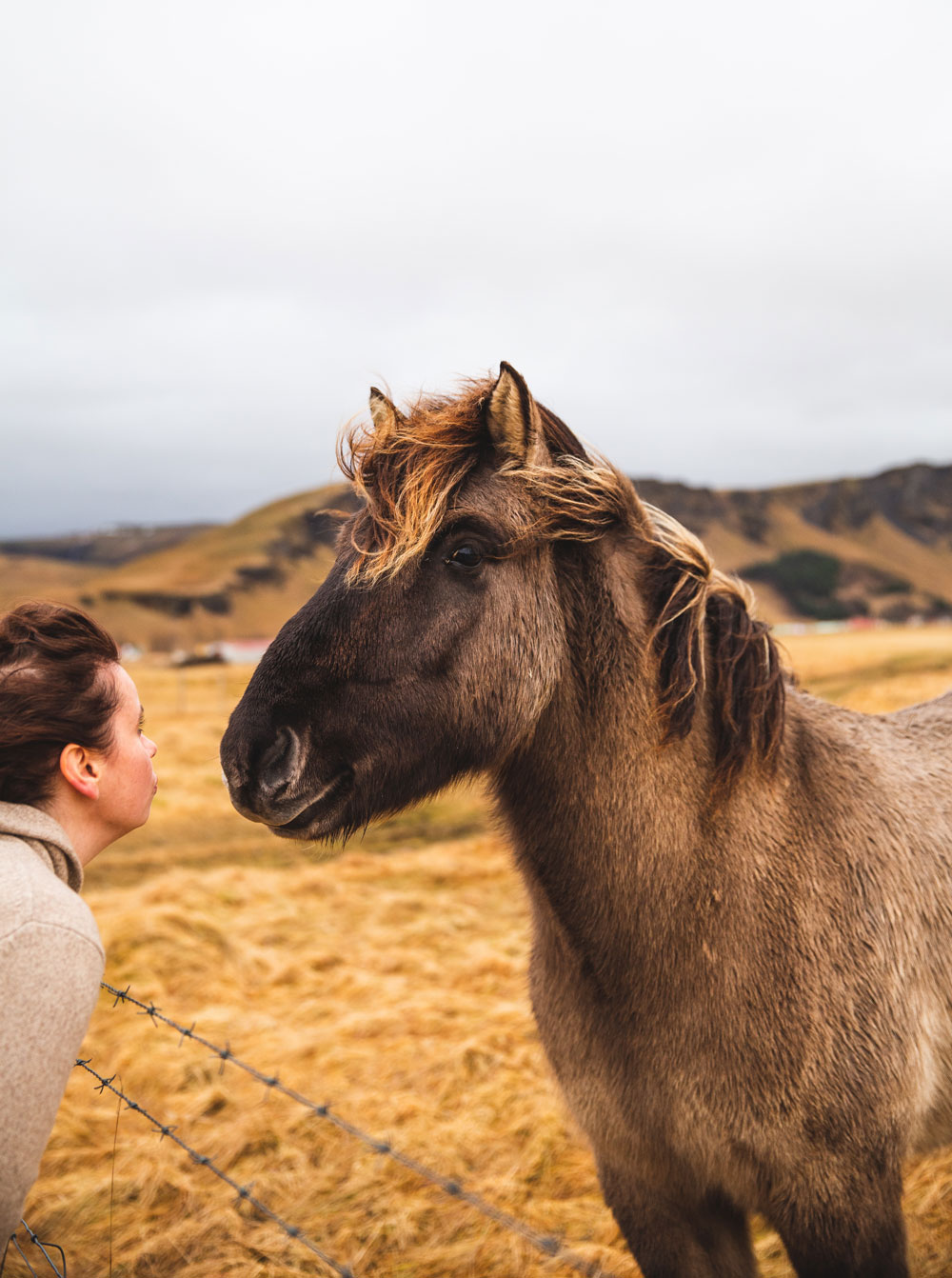
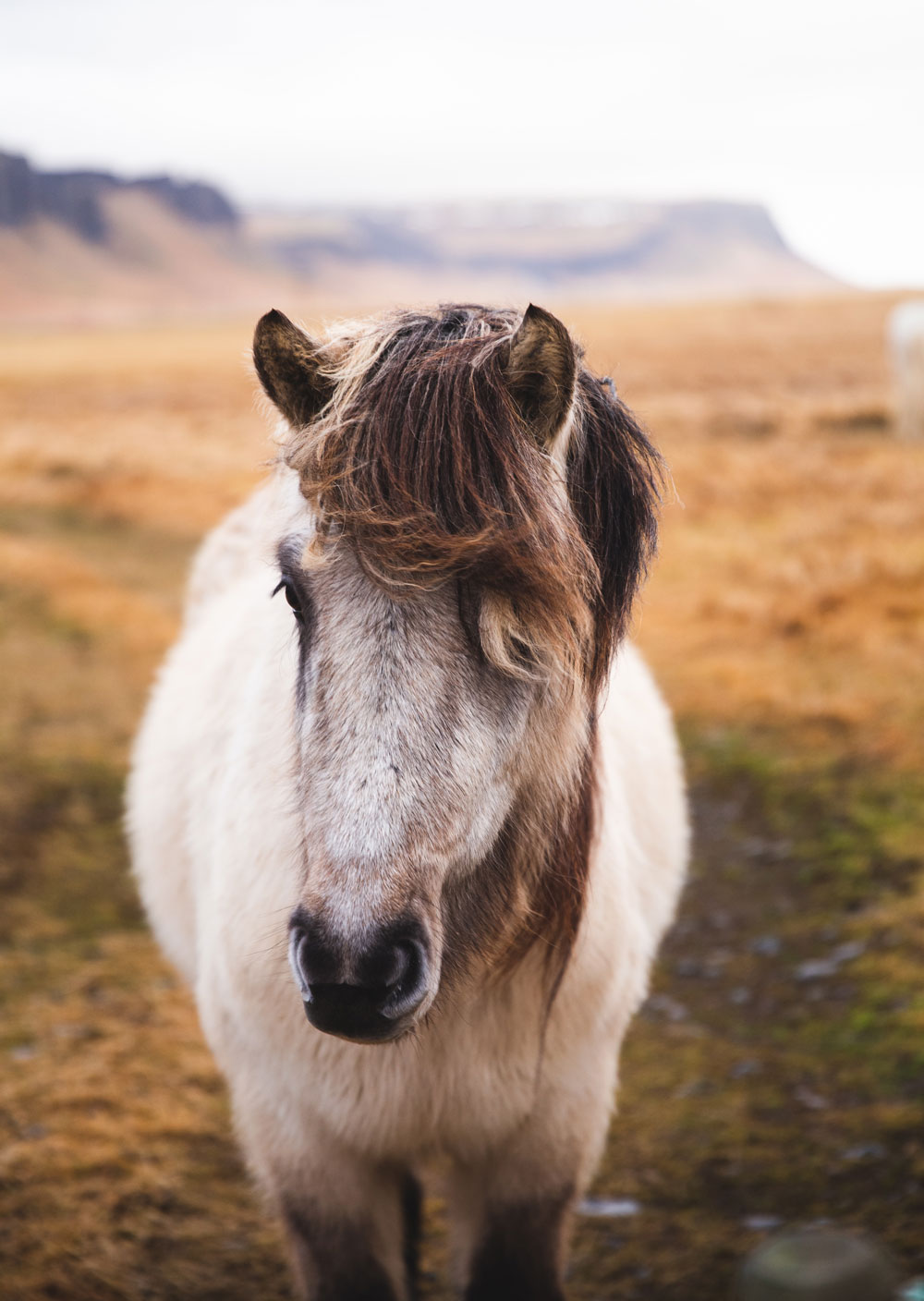
Aren’t those the Northern Lights?
In the evening we are eating at the nearby Hotel Skogar, when my Northern Lights app suddenly tells me that there will be a chance to see the Northern Lights that evening. There will be a hole in the otherwise heavy cloud cover at about 10.00 pm. Back in our own hotel I watch the sky and suddenly I can see it – a dim green light just above the mountains. I walk into the dark with my tripod, away from the hotel’s outdoor light. I set the camera and the green light appears on the screen. The light is even more powerful in my photos.
I wait for an hour in the dark, but the Northern Light never put on it’s grandest show. Around midnight the hole in the clouds closes up and the sky is covered once again. But I saw it! For the first time in my life I have seen the Northern Lights.
links:
You can find Hotel Lambafell here (which is well positioned for seeing the Northern Lights. The hotel also has its own outdoor hot tub)
The Northern Light app is called My Aurora Forecast and can be downloaded here
You can also check the official weather page of Iceland, which publishes a Northern Lights forecast each day. Find the forecast here.
Advice for seeing and taking photos of the Northern Lights:
1. Surprise! You have to look north. If you’re not the kind of person that has a compass in your pocket, there’s a compass on most mobile phones.
2. There are Northern Lights shows almost every night in Iceland. But whether you can see them or not depends on the strenght and the amount of cloud coverage. Often it’s more about finding a cloudless area than finding the Northern Lights themselves.
3. If you want to photograph the Northern Lights, you need a solid tripod. If you use a flimsy one, your photos will be blurry.
4. Set your camera to the lowest aperture you can. You can succeed with aperture of 3.5, but it’s even better with a faster lens of 2.8 or 1.4.
5. To avoid the stars creating lines in your photos, you should stay within a 10-second exposure time.
6. Remember to sharpen manually. Autofocus will not help you here. If you have live view in your camera, you can zoom in on the brightest star in the sky and turn the focus ring back and forth until the star is sharp. If you don’t have live view, you’ll just have to do some trial and error. Put the focus ring on infinity if you can and zoom in on the image you’ve taken. If it is still blurred, turn the focus ring a little back and forth until the photo is sharp.
Remember, that the camera can capture Northern Lights even though you cannot see it with the naked eye. Even if you can’t see anything, try taking photos of the northern horizon using the above method.
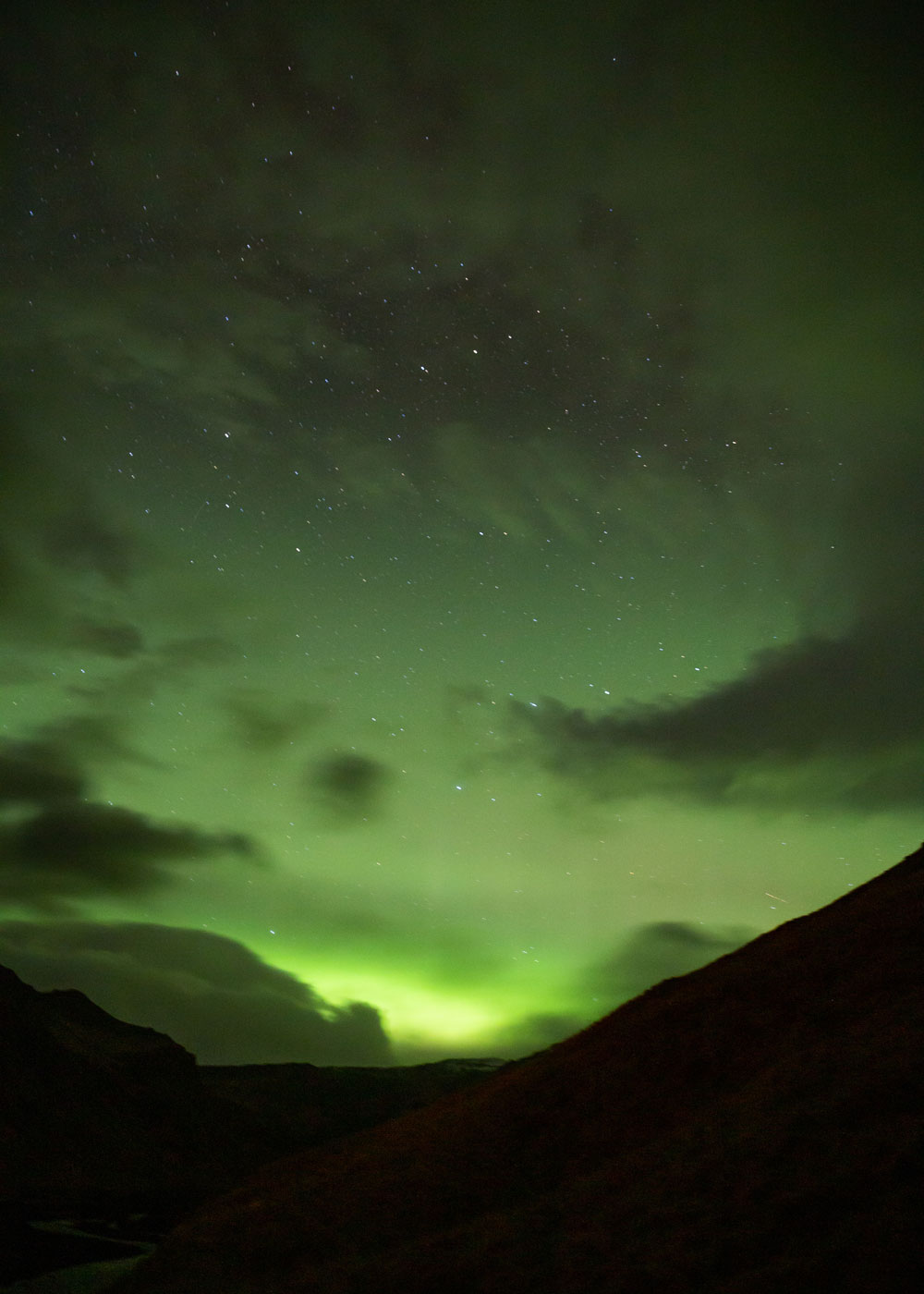
Day 4 – Mighty waterfalls and boiling mud pools
Driving: From Lambafell to Sandgerdi, 2 1/2 hours, 200 km
As we head off in the morning, the sky is full of pink morning clouds outside our hotel in Lambafell. One of the good things about traveling to Iceland in winter is that you can sleep in without missing the sunrise. The days are short and the light is beautiful.
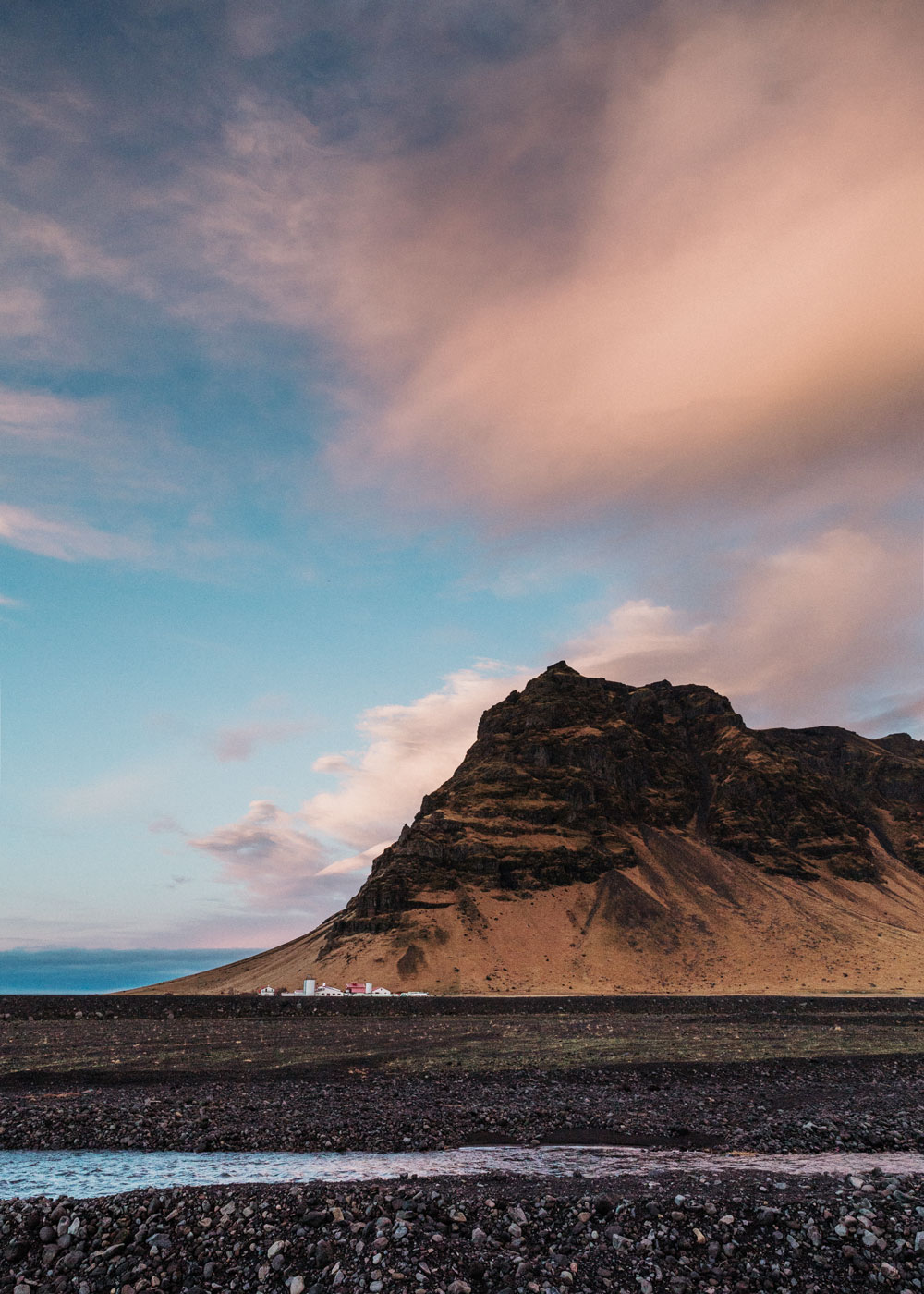
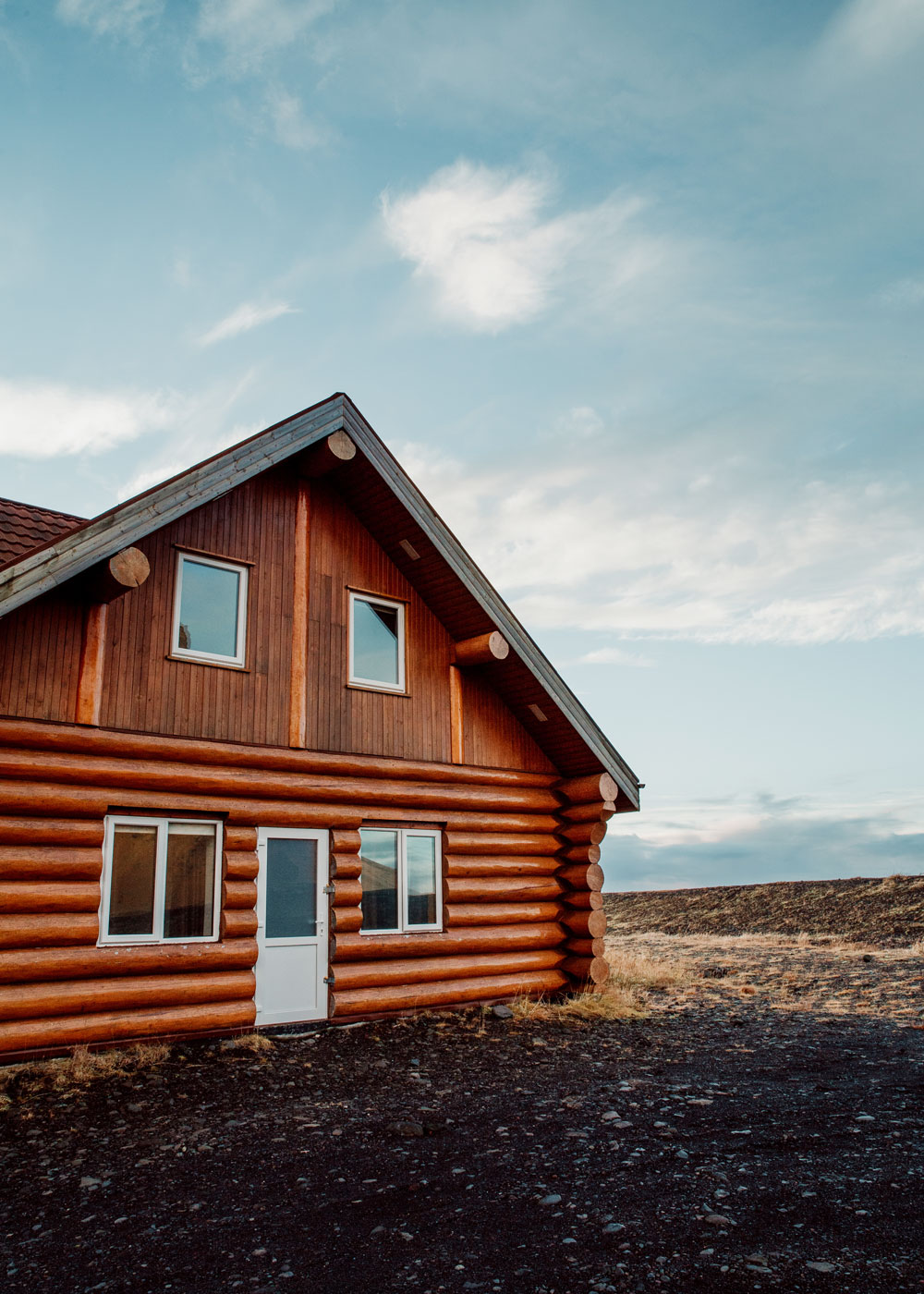
Seljalandsfoss waterfall
Today’s first attraction is the Seljalandsfoss waterfall, which is just off the ring road. The fantastic thing about Seljalandsfoss is that you can go all the way around and behind it and then out the other side. From all angles, the waterfall is an impressive sight. You can’t help getting wet, so rain gear and a bag over your camera are good ideas. A little further along is another waterfall, Gljufrabui, and this one can be seen by entering the narrow gorge through the stream. If you have waterproof hiking boots you can walk on the biggest rocks and avoid getting wet feet. Inside the cave the waterfall drapes down the cliff and is almost invisible from the outside.
Seltun geothermal area
After Seljalandsfoss we set the GPS to take us to Seltun, which is one of the sights near Reykjavik. The geothermal area is also called Krysuvik. This is the place to go if you want to experience Iceland’s geothermal activity, boiling mud pools and the ground that smokes and bubbles. On the walkways you get up high above the area to see the most beautiful colors. The smell of sulfur gets in your nose and you are wrapped in clouds of steam.
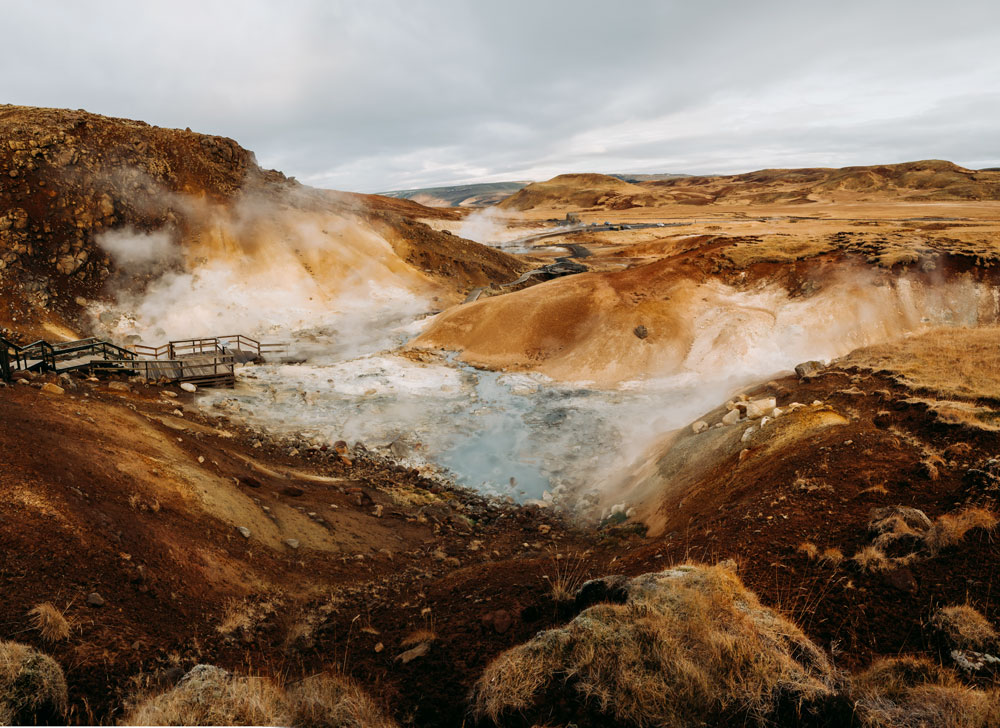
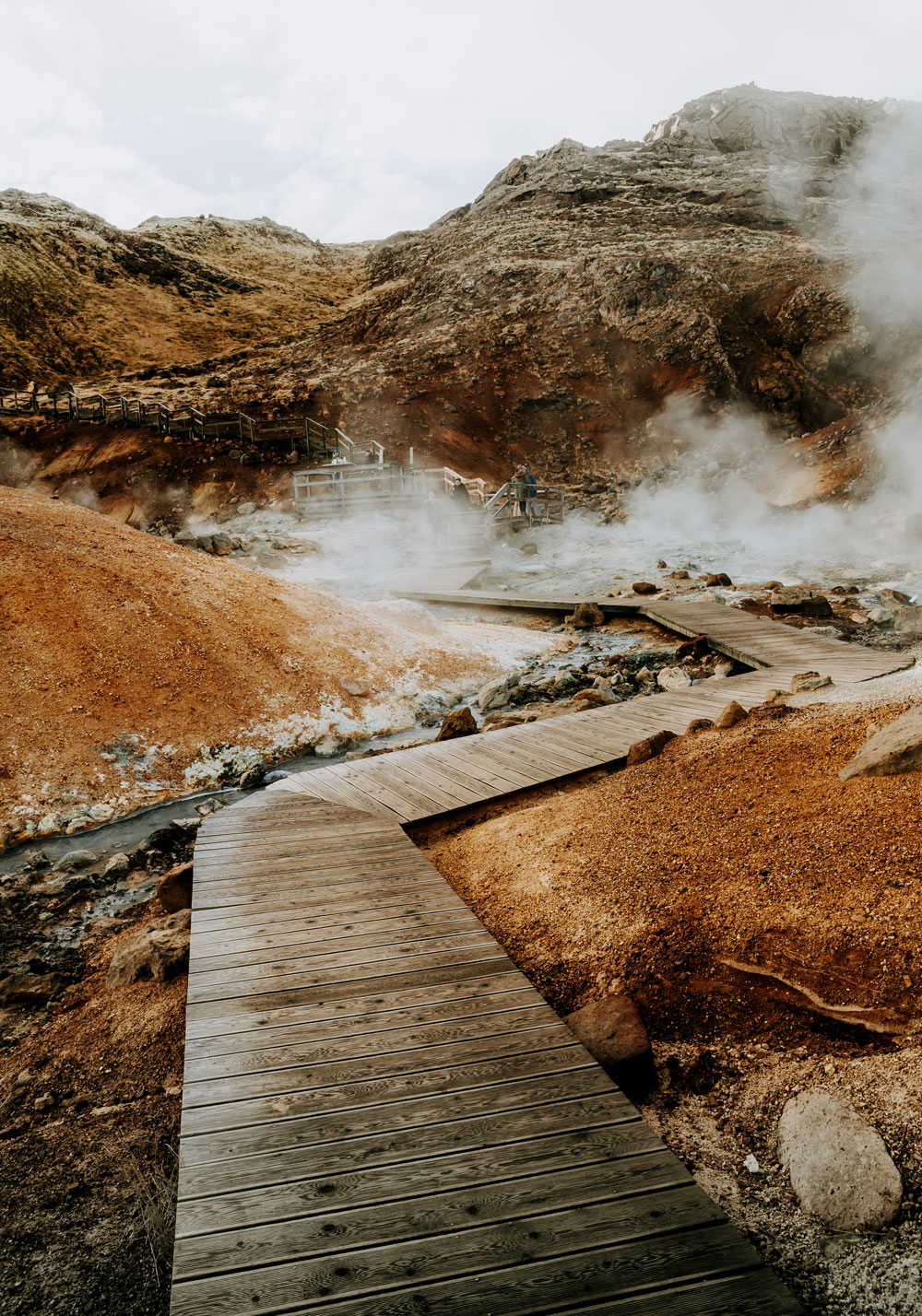
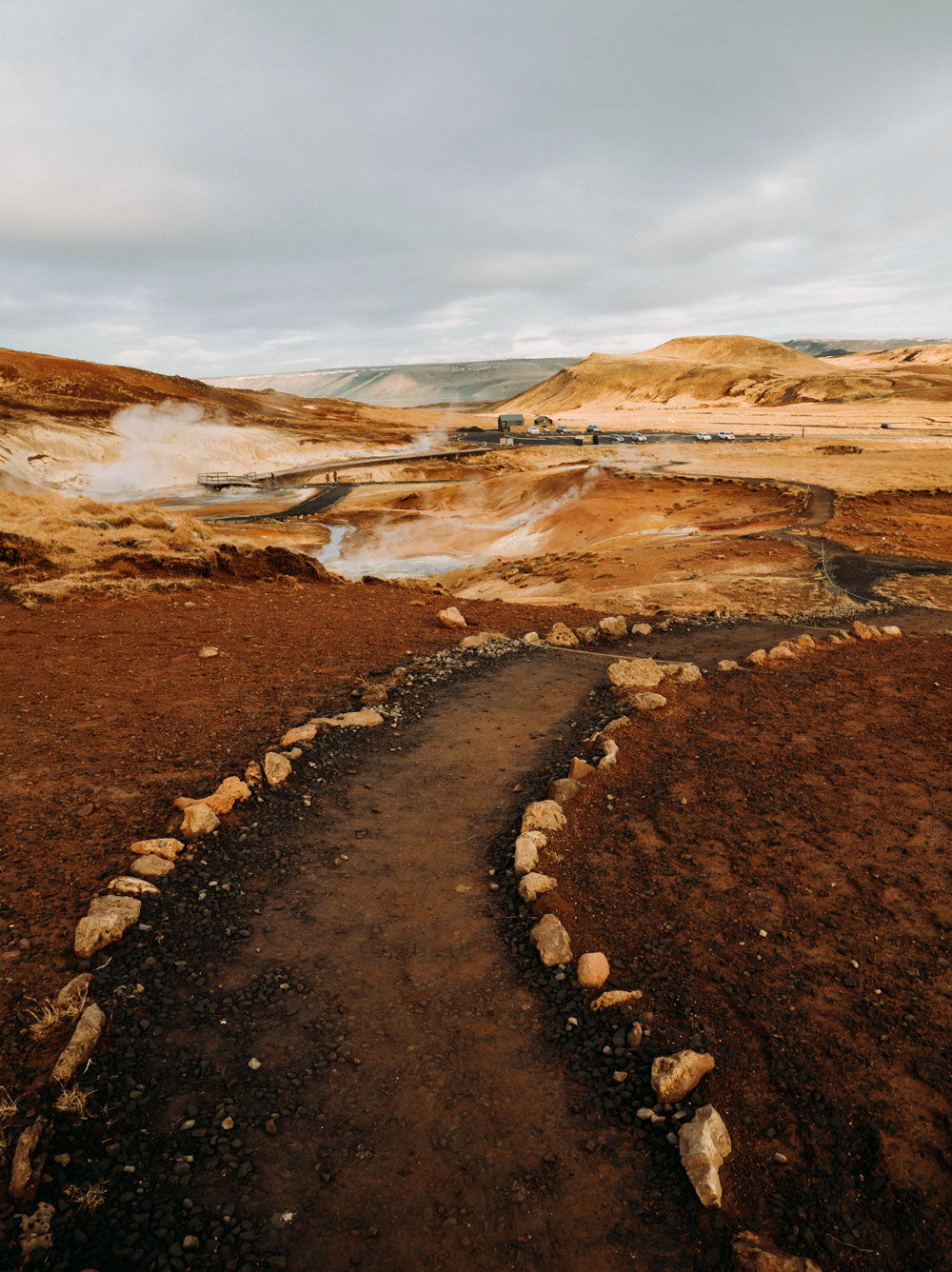
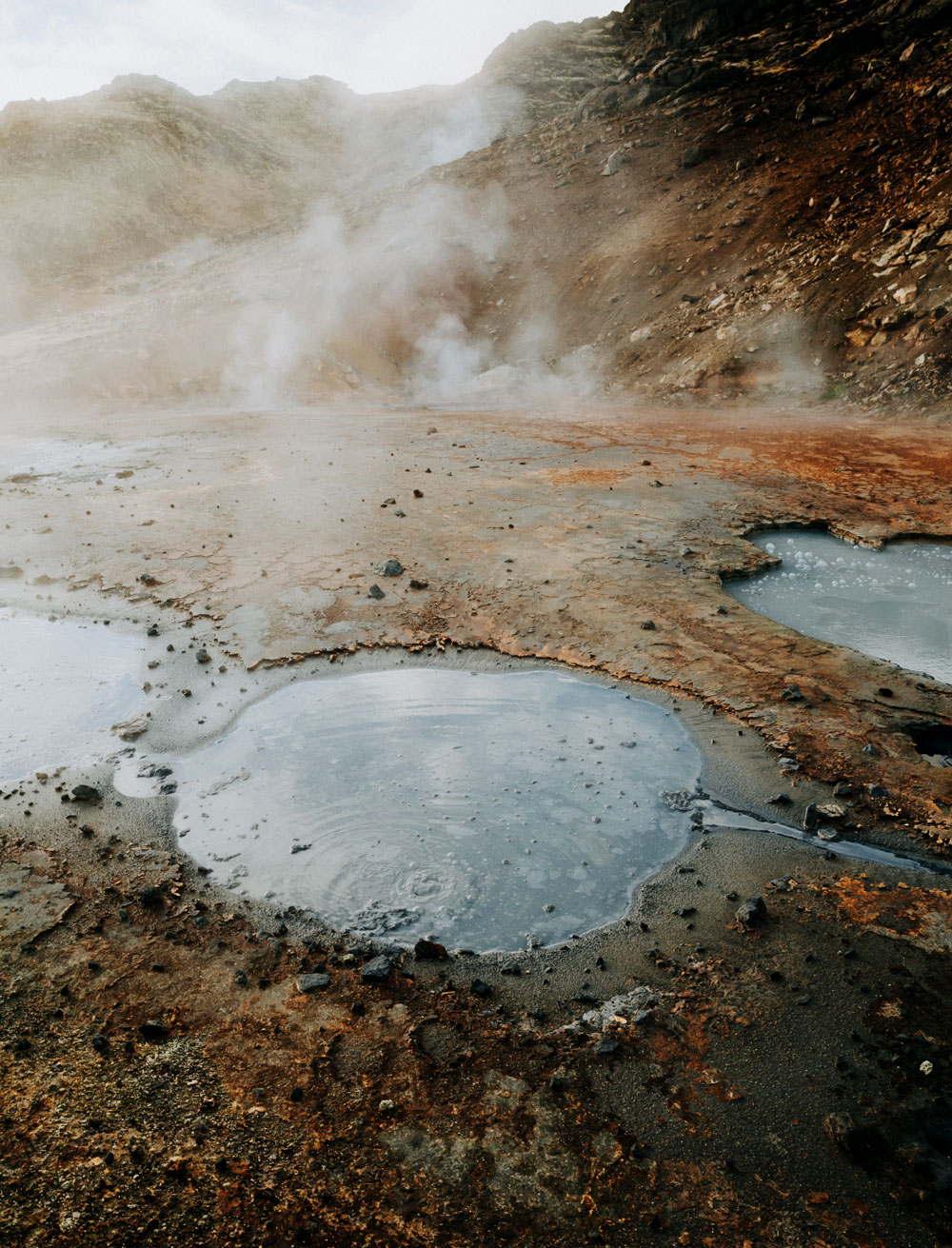
Day 5 – the last night near Keflavik Airport
On our last night in South Iceland we stay near Keflavik Airport, close to the small town of Sandgerdi. Right by the coast in a cozy cabin. On the terrace we find our own private hot tub, heated and ready when we arrive. We have booked this cabin because we would like to be close to the airport for our last night, but also in order to have a last chance to see the Northern Lights away from the city and its light pollution. The plan is to lie in our hot tub and look up for the Northern Lights, but on this night the sky is completety cloudy. We just lie in our hot tub gazing into the darkness, which is certainly not a bad end to our Iceland trip. The next morning we have just a half-hour drive to Keflavik, where our plane awaits us.
You can find the cottages in Sandgerdi here
When is the best time to visit Iceland in winter?
If you want to experience the ice caves, plan your visit for sometime between November and March. You can see the Northern Lights from September to March, but the chances of seeing them are, of course, greater, the longer the nights are. If you are only coming to see the Northern Lights, you can make your trip in the middle of December, when the days are only 4 hours long. On the other hand, if you want to spend some time exploring Iceland’s sights in daylight, you should visit in November or February.
You can check the length of days on this website
You can check the average temperature in Iceland throughout the year on this link
This is why you should visit Iceland in the winter
1. Winter in Iceland is milder than you think. Due to the warm Gulf Stream it rarely gets below -5 degrees Celsius. And yes the weather is incredibly unpredictable, storms and snow showers can arise out of the blue, but the weather is also quite unpredictable in the summer.
2. The Northern Lights – it needs no sales pitch. A photo guide once told me about people who cry the first time they see the Northern Lights.
3. If it gets a bit too cold, you can always jump in one of the many hot springs and pools. It’s quite an amazing experience to sit in 40-degree water when the air outside the pool is freezing.
4. There are fewer tourists in winter. Over the last few years, Iceland has become a booming tourist destination. In some places there are still many tourists in the winter, but still, there are fewer than in the summer.
5. In winter the days are short and the light is incredibly beautiful. You do not have to get up early to experience the sunrise.
6. The many beautiful sights are just as beautiful in the winter as they are in the summer. And the cute Icelandic horses are outside all year round.
Like this post? Save it on Pinterest
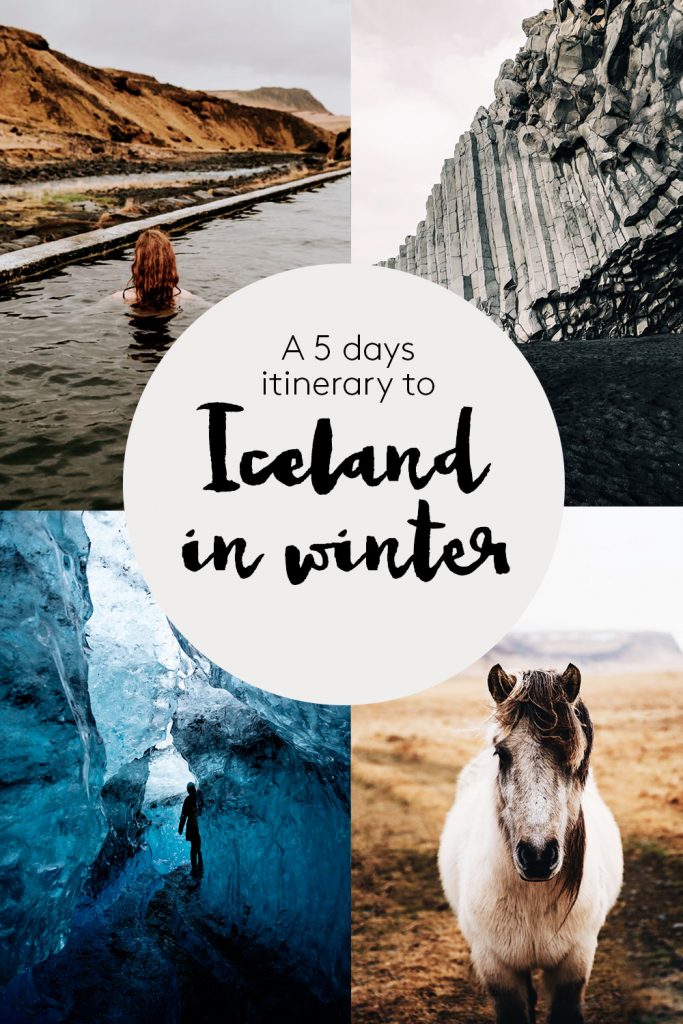
SarahintheGreen is ambassador for Momondo. Read more about the collab right here


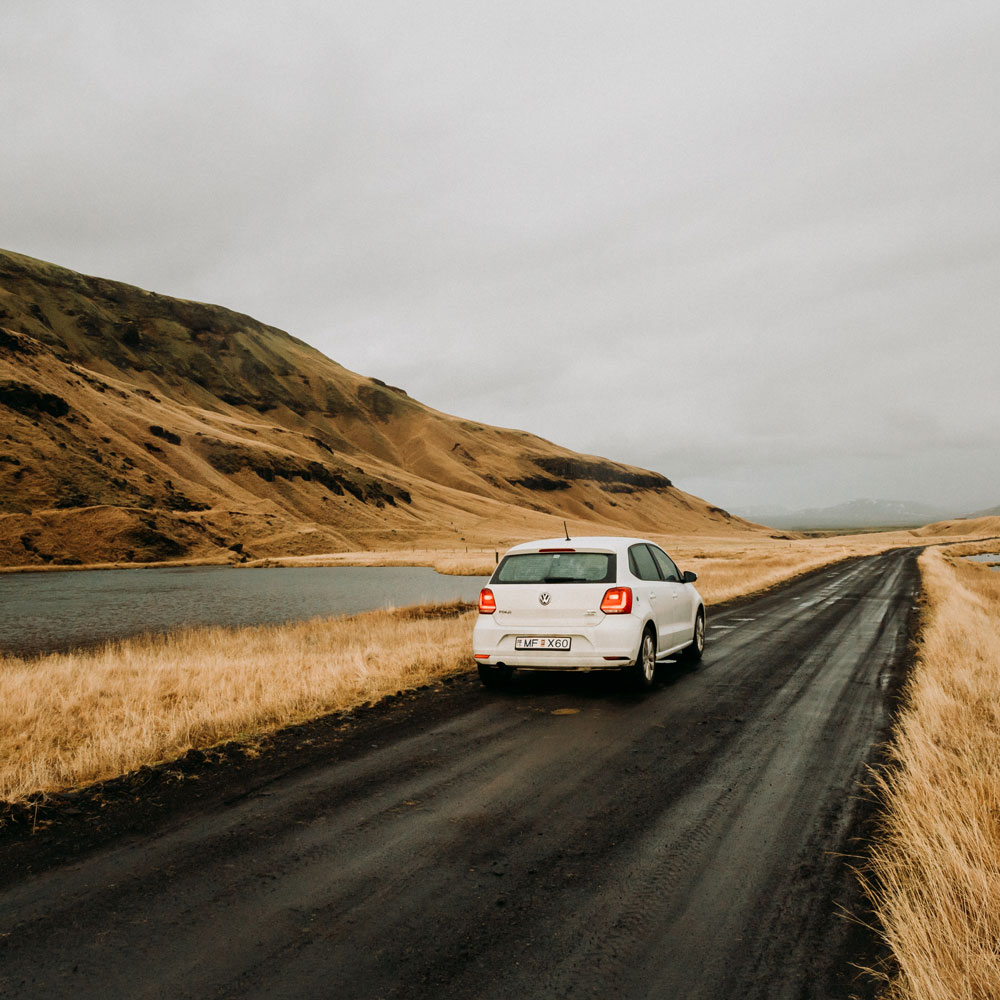
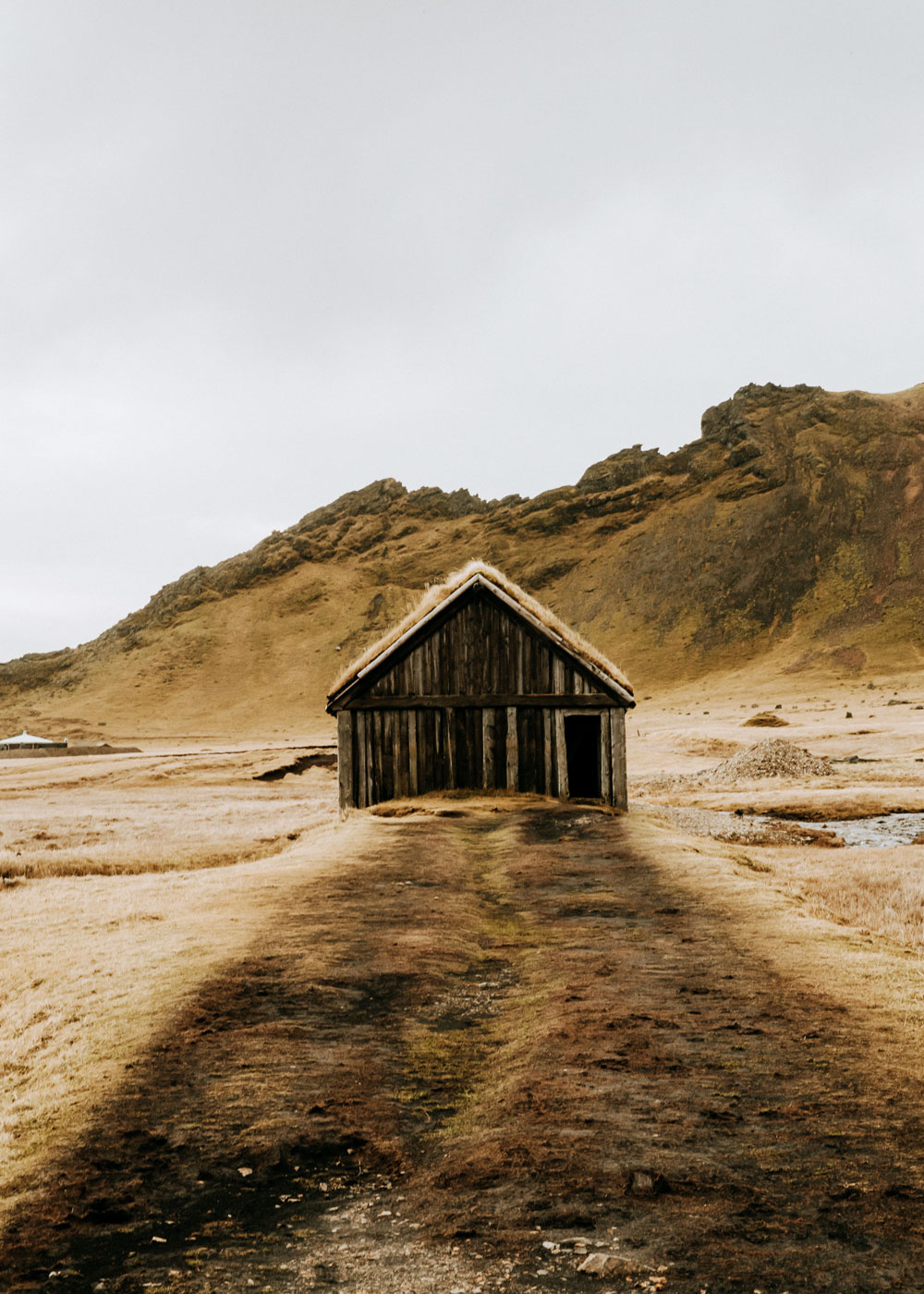
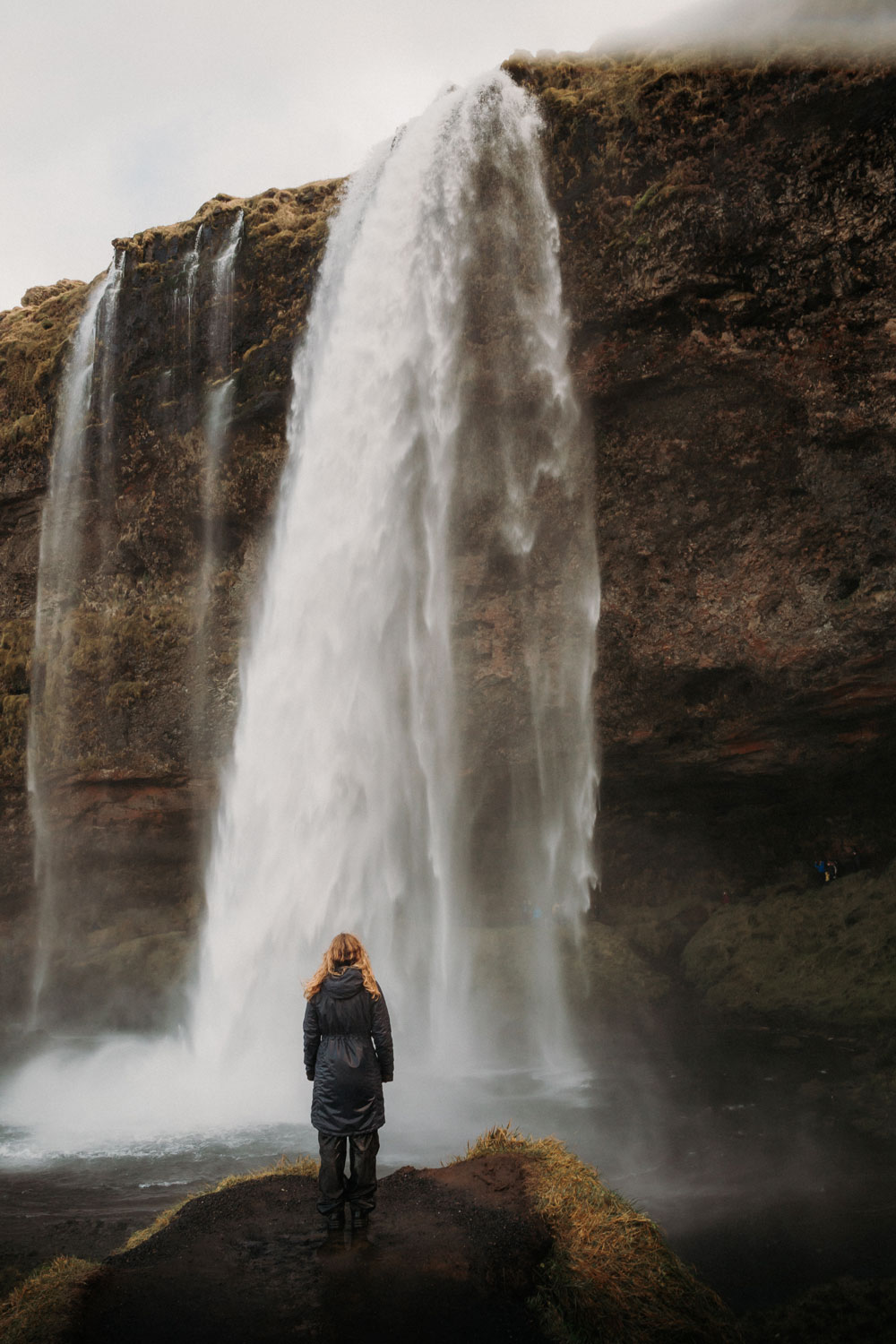
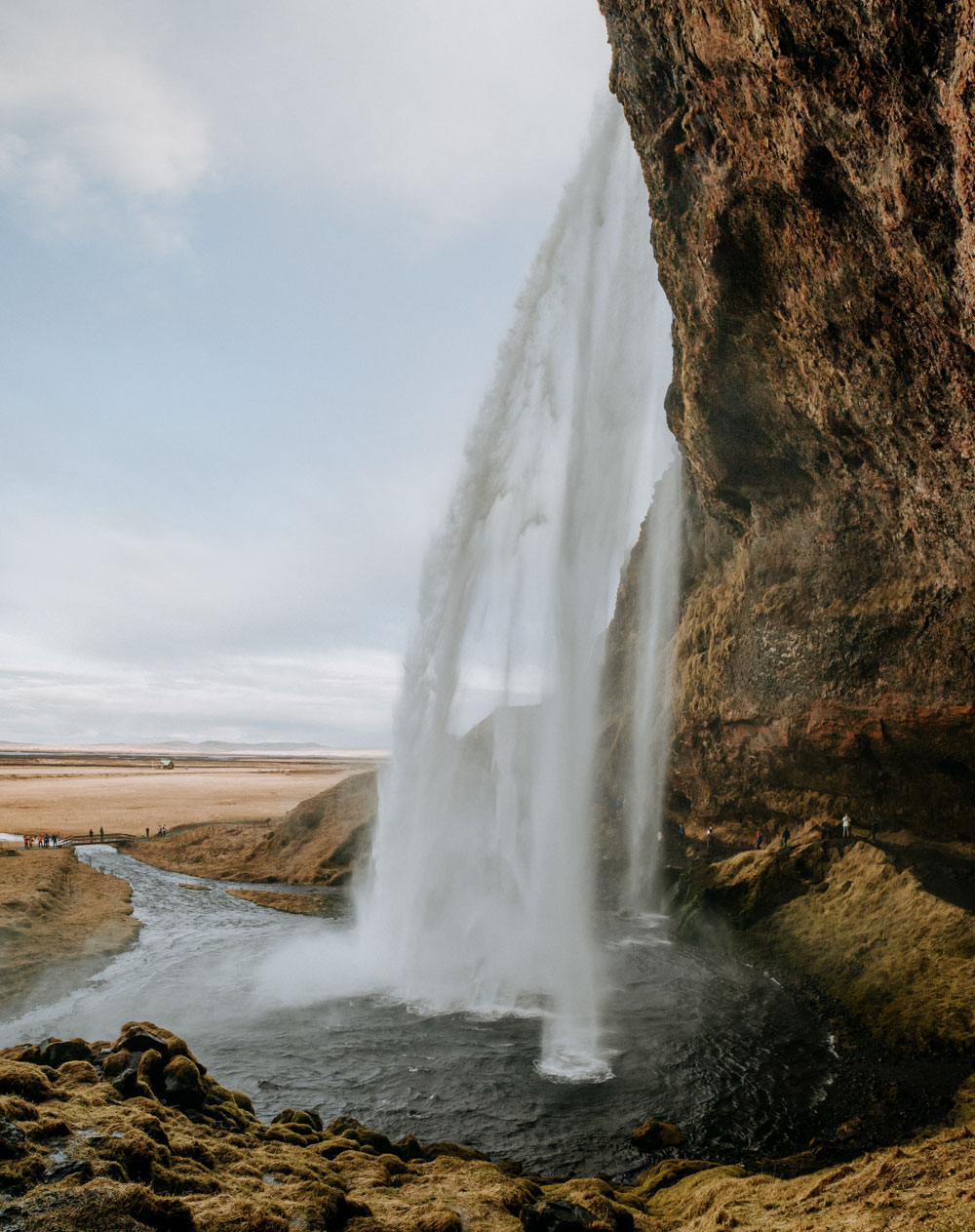
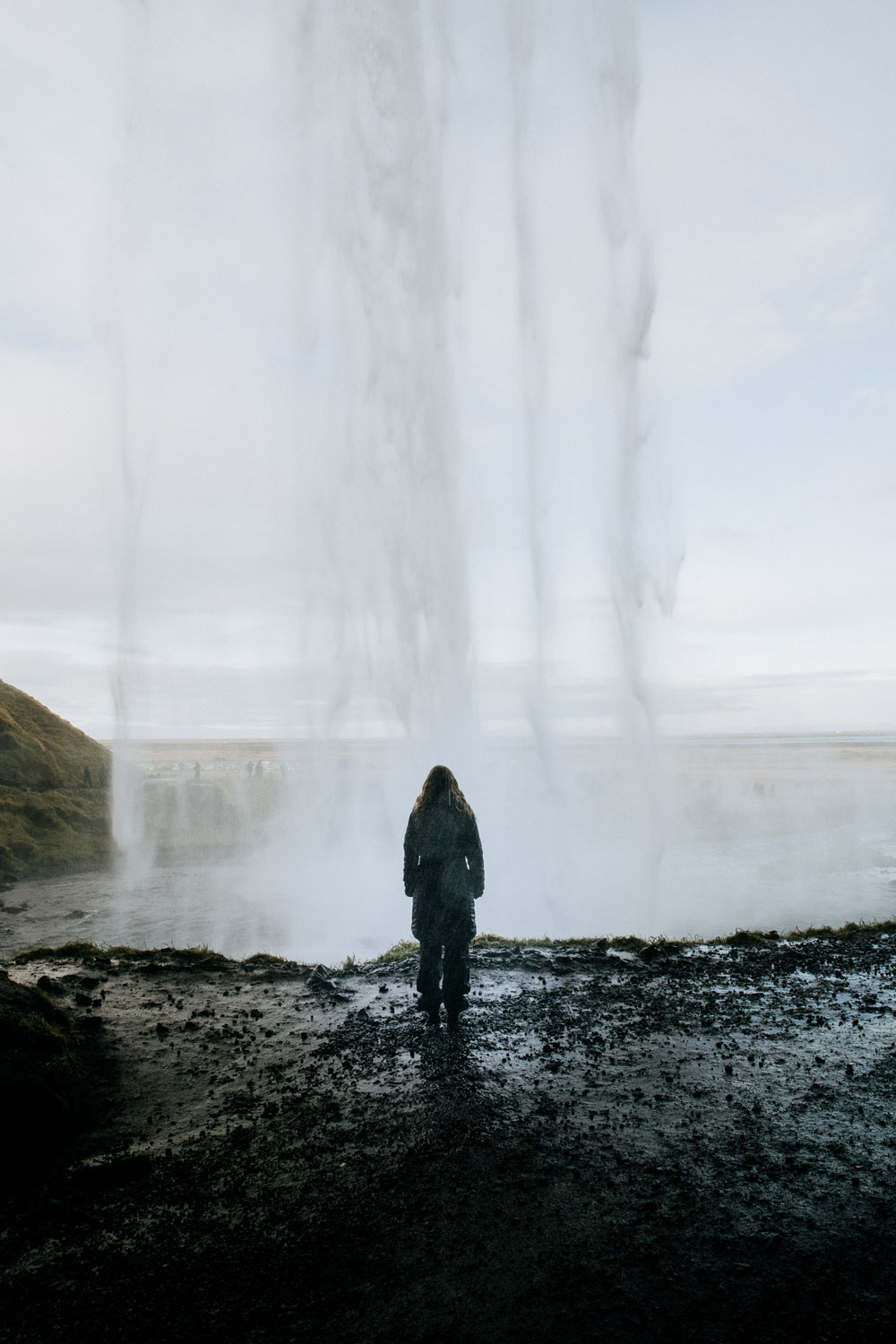
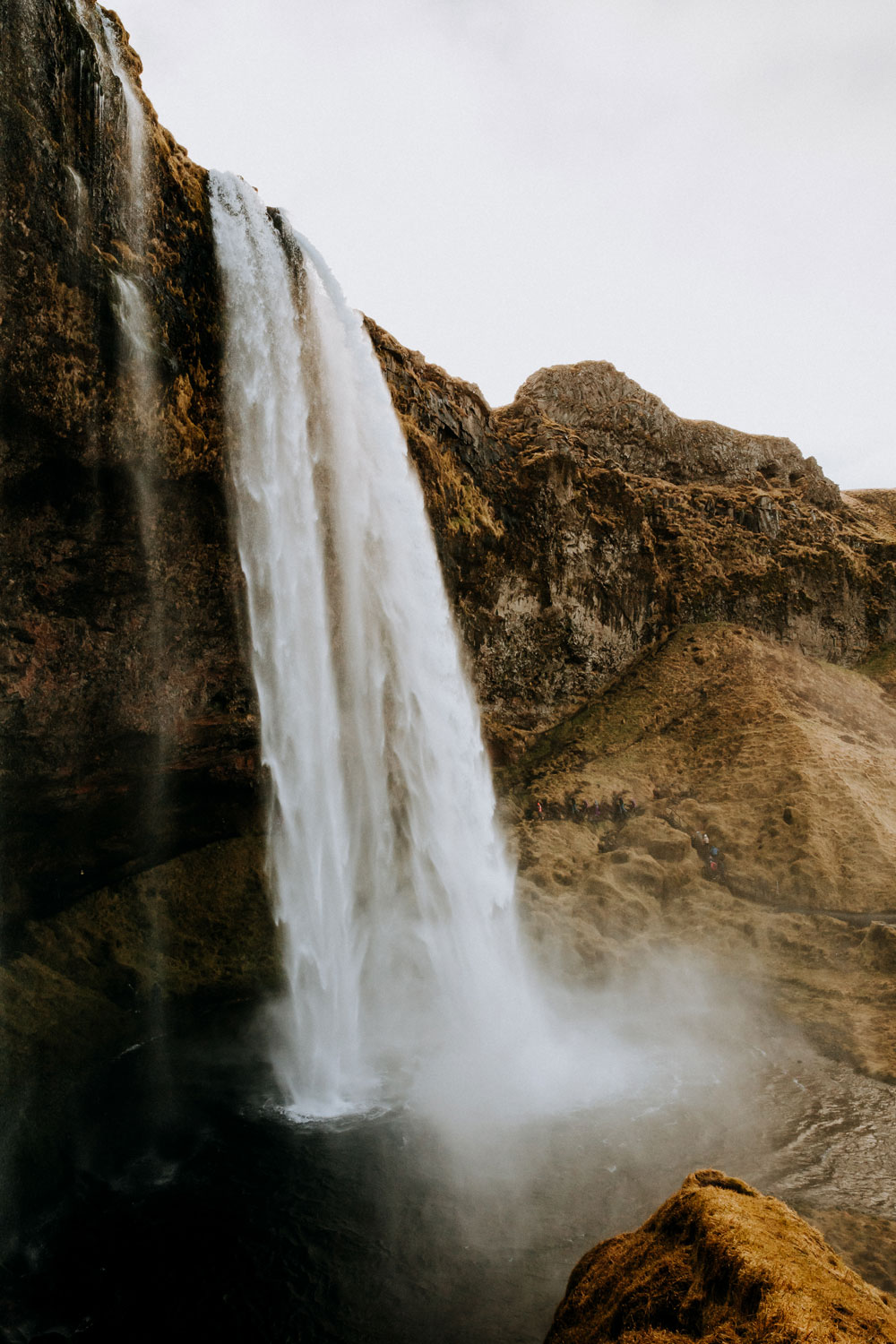
No Comments